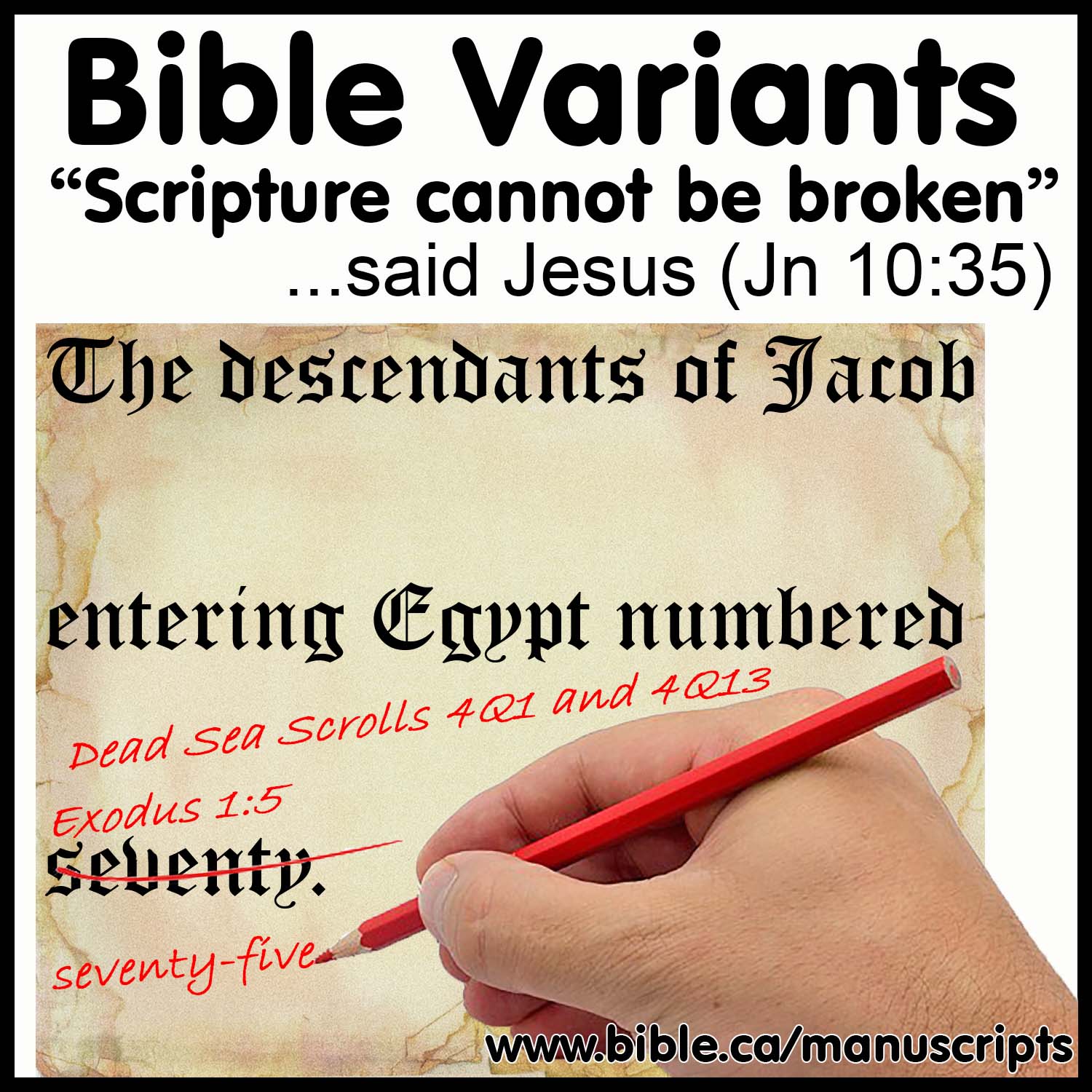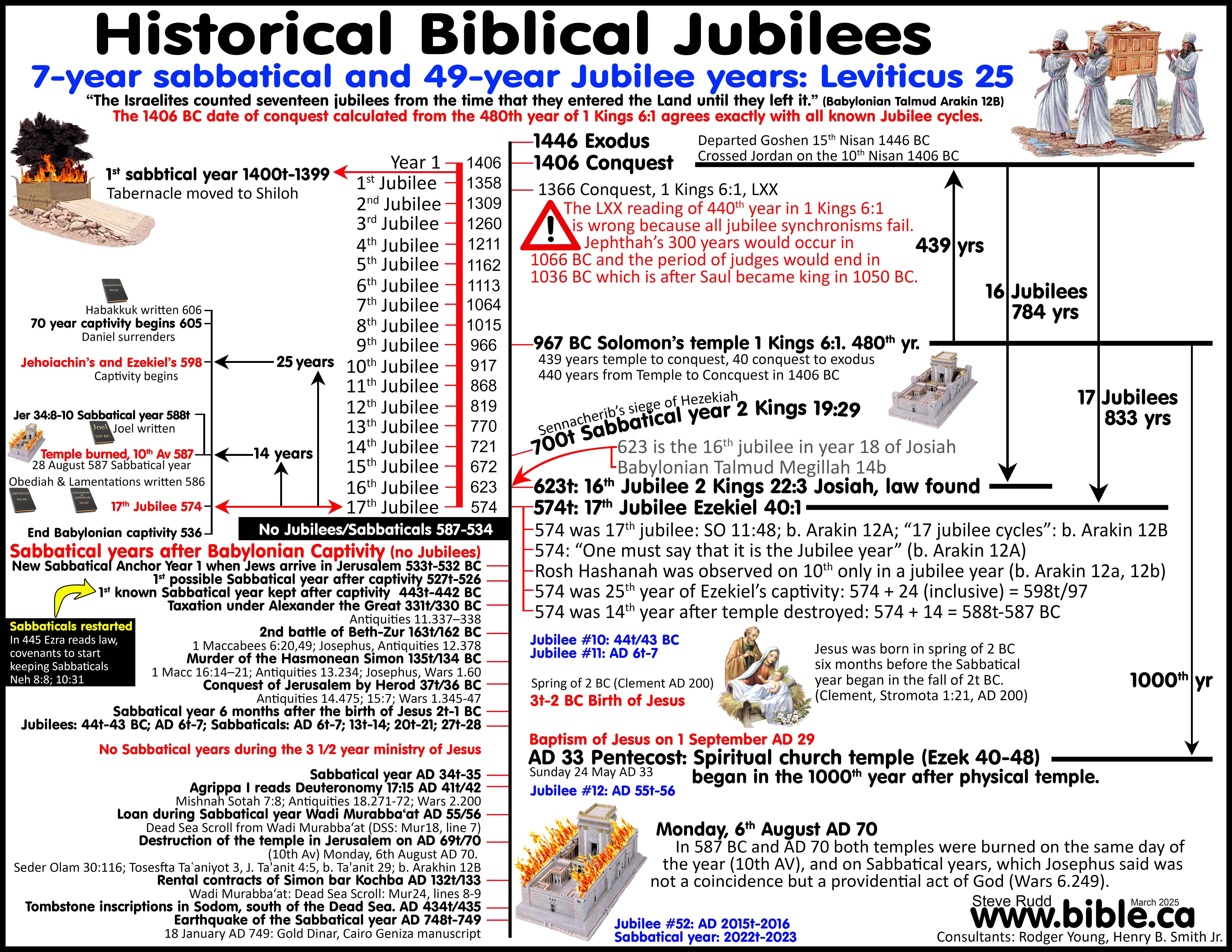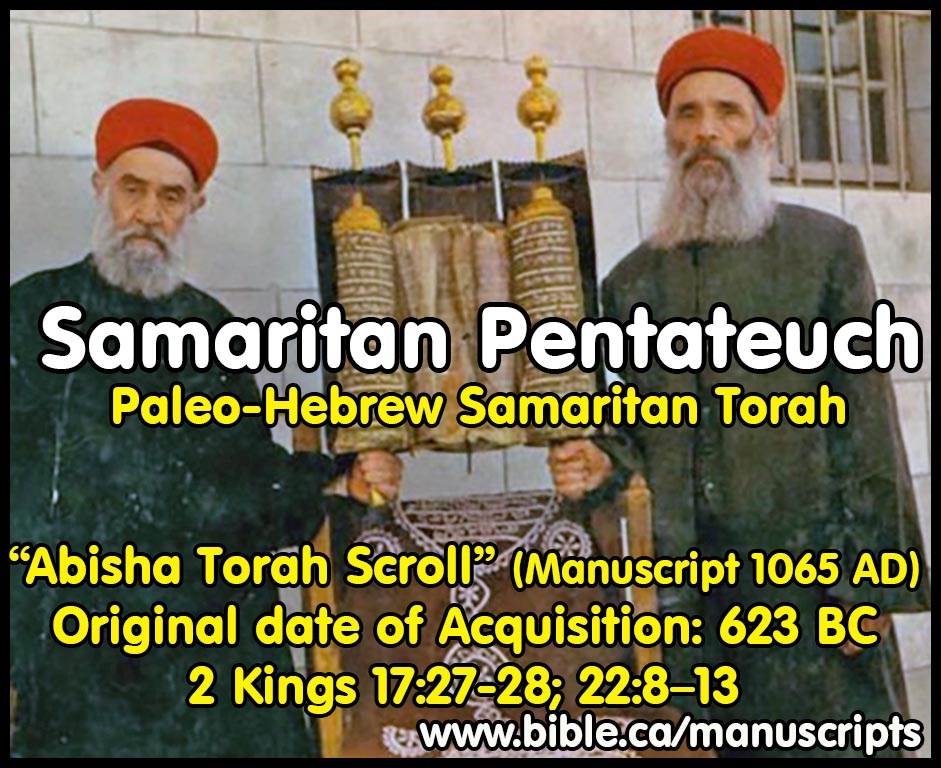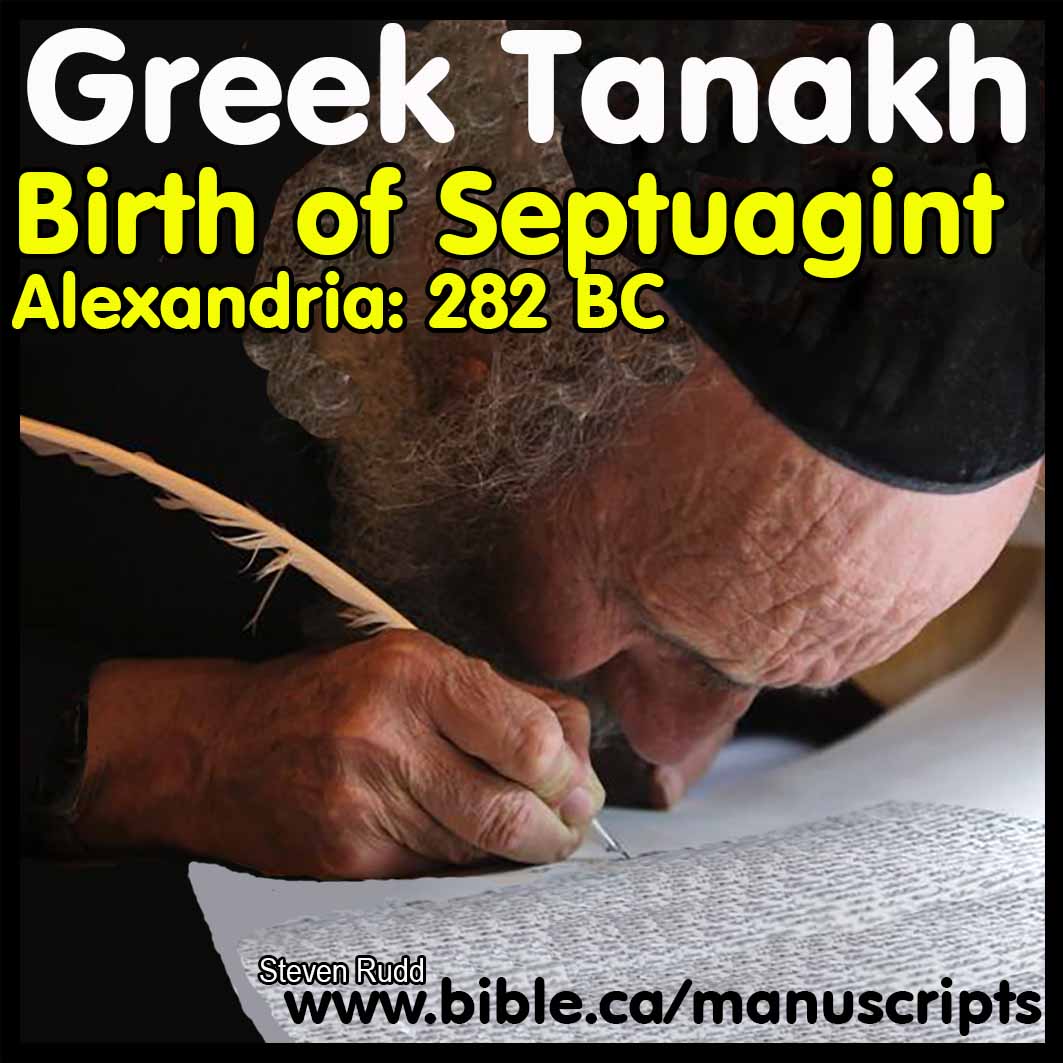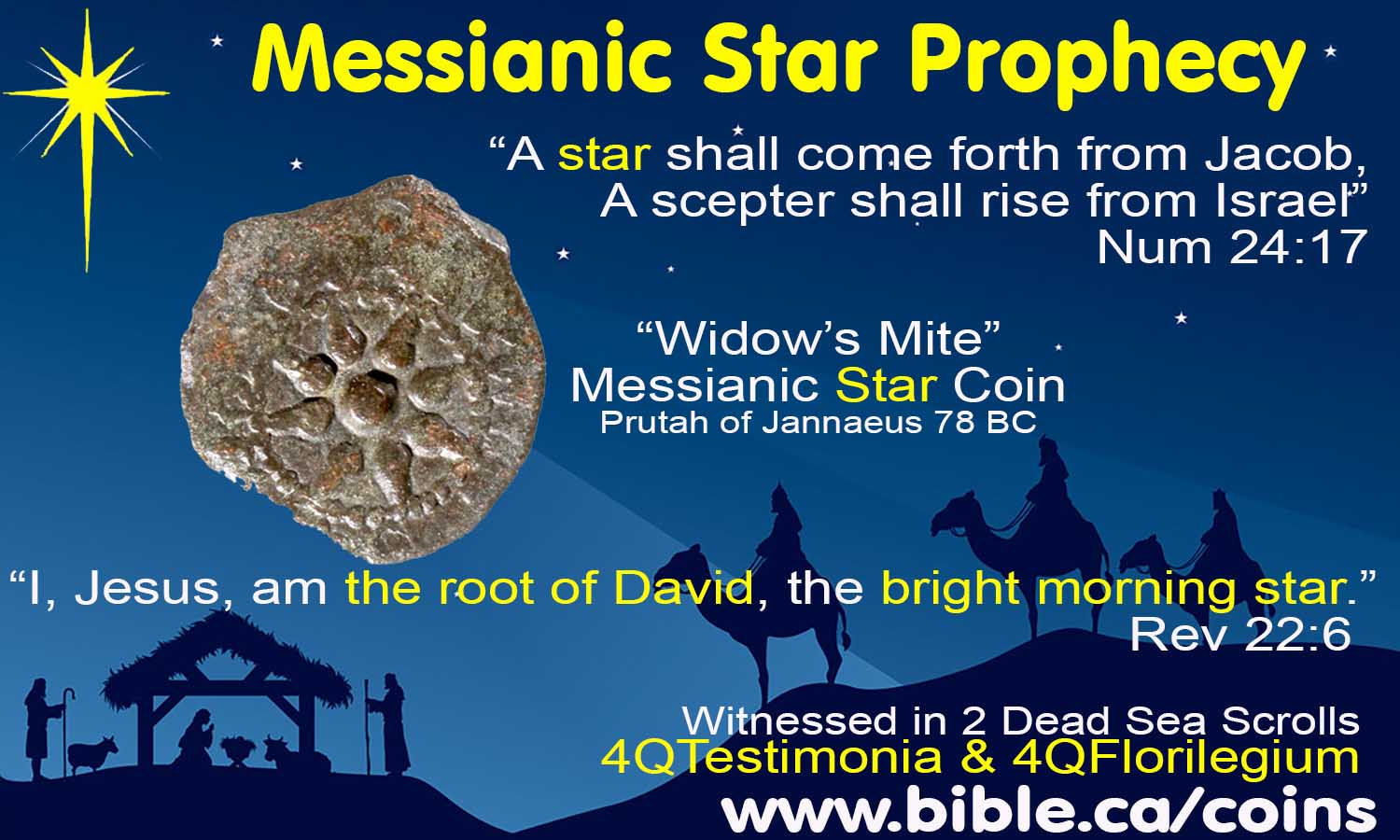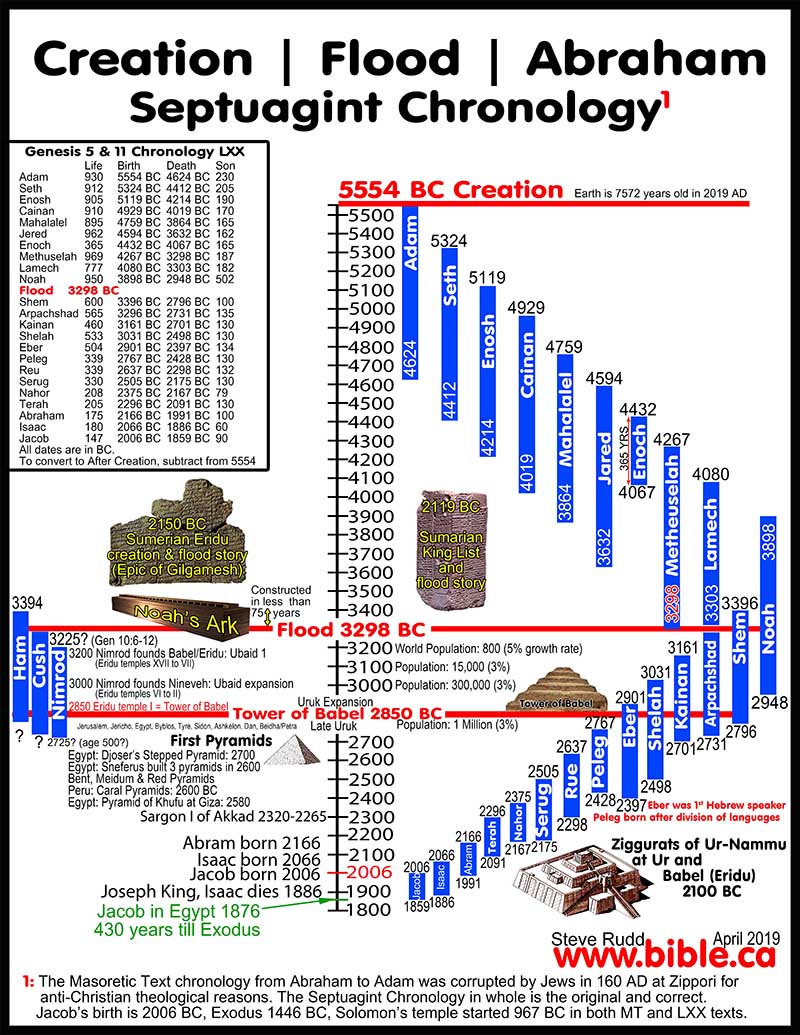|
Textual Variants in 1 Kings 6:1 480 vs 440 years Date of the Exodus: 1446 vs 1406 vs 1366 "Scripture cannot be broken" (Jesus, John 10:35) "My word will accomplish what I desire and succeed in the purpose for which I sent it." (Isa 55:11) Steve Rudd March 2025 |
Textual Variants in the Book of 1 Kings 6:1: 480 or 440 years
Bible textual variants analysed
Introduction:
|
Hebrew Masoretic (MT): 480 |
Greek Septuagint (LXX): 440 |
|
In the 480th year of the Era of Israel’s Exodus from Egypt, in the fourth year of Solomon’s reign over Israel, in the month Ziv, which is the second month, he began to build the house of the Lord. (1 Kings 6:1, translated correctly by Rodger C. Young) |
"It happened in the four hundred and fortieth year of the exodus of the children of Israel from Egypt, in the fourth year at the second month of the rule of King Solomon over Israel," (3 Kingdoms 6:1) |
1. Variants in 1 Kings 6:1 of 480 vs. 440 change the date of the exodus to 1446 BC vs. 1406 BC
a. With the founding of Solomon’s temple in 967 BC as a well established chronological anchor point, 1 Kings 6:1 counts back to the exodus with 480 in the Hebrew MT producing an exodus of 1446 BC or 440 in the Greek LXX producing an exodus of 1406 BC. The conquest for each is calculated by subtracting 40 years producing 1406 BC and 1366 BC respectively.
b. All known Hebrew Masoretic (MT) manuscripts read 480 without variant.
c. The Variants of 480 and 440 in 1 Kings 6:1 stem from a corrupt Greek Septuagint text and the Hebrew Masoretic text is unquestionably the correct and original reading.
d. Thanks to Henry B. Smith Jr. below are 31 Greek (LXX) manuscripts listed. 5 of these 31 manuscripts read 480, while 26 read 440. It is important to note that the LXX has other known chronological confusions, like the Egyptian sojourn seems to be 215 years in the LXX rather than the correct 430 years in the MT. The LXX, in Exodus 12:40, incorrectly has the 430 years include the time the Israelites were in both Egypt and Canaan, whereas the correct chronology of this time, as given in the MT, includes only the time in Egypt, putting Jacob’s entry into Egypt in 1876 BC.
e. “The Greek text of 1 Kgs 6:1 puts “of the departure/Exodus” in the genitive, which necessarily means that the number 440 given in most LXX manuscripts is to be taken as an ordinal number, not a cardinal number. Both the Hebrew and the Greek say that it was in the certain year (480th for MT, 440th for LXX) of an era, not that many years “after” the Exodus. Just as in the Hebrew, there is no word “after” in the LXX of the passage. Both the Hebrew and the Greek say that it was in the 480th year of the “going-out” (Exodus) not 480 years “after” the Exodus.” (Rodger Young, editorial comment, AD 2025)
2. Proper translation of 1 Kings 6:1: The world has been blessed with conservative God-fearing men like Rodger Young, who has established that the temple of Solomon began to be built in the 480th year from the exodus, which is 479 years, not 480 years to compute an exodus in 1446 BC. Rodger was able to establish that the temple was founded in 967 BC instead of 966 BC. Using Thiele’s erroneous date (off by 1 year short) and adding 480 years (off by one extra year), the correct year of the exodus was calculated in 1446 BC. When Rodger corrected the year to 967 BC, then proved that the correct translation of 1 Kings 6:1 was “in the 480th year of the exodus” rather than “480 years after they exodus”, the math computed the same correct date of the exodus in 1446 BC. As a secondary witness, the Septuagint correctly translates 1 Kings 6:1, “in the four hundred and fortieth year of the exodus”. Rodger explains:
a. “The establishment of the Exodus Era. In Exodus 12:1–2, the Lord instructed Moses and Aaron that the current month, called Nisan after the Babylonian captivity, was to be reckoned as the first month of their calendar. A logical consequence was that it would also mark year one of a longer-term calendar, such as the previous paragraph showed to be useful to civilizations ancient and modern. Did Israel so reckon? That they did indeed establish an Exodus Era, in which the year the Exodus happened was counted as “year one” of that era, is established by eight texts in the Pentateuch and one text in 1 Kings. These texts are listed in Table 1. Analyzing, or merely considering, these texts should leave no question but that Israel, following the lead of Exodus 12:1–2, had established an era by which to measure the passage of time, thereby providing the necessary timeframe for contracts and the observance of religious festivals. This would include the Jubilee and Sabbatical Years. The usage of that era, the Exodus Era, continued at least until the time of Solomon. It was in his reign that we have the last recorded year determination in terms of the Exodus Era, when it is said that Solomon began building the temple in the 480th year of the “going-out,” that is, of the Exodus Era. The Hebrew of 1 Kings 6:1, by putting לְצֵאת in the construct state, necessarily implies that the preceding “480 year” figure is an ordinal number: 479 years had passed since the Exodus, not 480 as erroneously implied by all translations that insert an “after” that is not in the Hebrew text. In this regard, Andrew Steinmann writes regarding 1 Kings 6:1, “The Hebrew expression here indicates that Israel’s Exodus initiated a chronological era in which the Exodus itself occurred in year one of that era, and temple construction began in year 480 of that era, that is, 479 years after the departure from Egypt.” Thus, temple construction began in the 480th year of the Exodus Era, not 480 years after the Exodus.” (Ezekiel’s Jubilee: Real or Rabbinic Fiction?, Part 1: Ezekiel 40:1 and 1 Kings 6:1, JETS 67.3, p486, 2024 AD)
3. Jubilees and Sabbatical years date the conquest to 1406 BC not 1366 BC:
a. The 1406 date of conquest as calculated from the “480th year” of 1 Kings 6:1 agrees exactly with the 17th Jubilee starting on Tishri 10 (Day of Atonement) in 574 BC. The date of the vision of the last nine chapters of the book of Ezekiel occurred on the Day of Atonement, Tishri 10 574 BC, can be established independently of any calculation starting with 1406 BC and measuring 17 Jubilee cycles after that date. It is this “coincidence” of two independent means of determining that a Jubilee year began in the fall of 574 BC—one means from the establishment of the dates of the Exodus and entry in the land as derived from 1 Kings 6:1, the other based solely on an examination of the five time phrases in Ezekiel 40:1, that has never been explained by those who do not accept a fifteenth century Exodus. For an examination of why all five time phrases in Ezekiel 40:1 are consistent with the vision occurring on the first day of a Jubilee year read this: Ezekiel’s Jubilee: Real or Rabbinic Fiction?, Part 1: Ezekiel 40:1 and 1 Kings 6:1, JETS 67.3, 2024 AD)
b. The 1446 BC date of exodus as calculated from the “480th year” of 1 Kings 6:1 agrees exactly with all known or reasonably determined Jubilee and Sabbatical cycles from 1406 BC down to the last known Jubilee in 574 BC with a 100% match rate.
c. If we use the “440th year” from the Septuagint of 1 Kings 6:1 it produces a conquest of 1366 BC that contradicts all known or reasonably determined Jubilee and Sabbatical cycles, with a 0% match rate.
4. Jephthah’s 300 years refutes a conquest of 1366 BC: Judges 11:26
a. "While Israel lived in Heshbon and its villages, and in Aroer and its villages, and in all the cities that are on the banks of the Arnon, three hundred years, why did you not recover them within that time?" (Judges 11:26)
b. Jephthah said he lived at a time which was 300 years after the conquest. If the “440” reading is accepted in 1 Kings 6:1, this produces a conquest date of 1366 BC. Jephthah’s 300 years would occur in 1066 BC and the period of judges would end in 1036 BC which is after Saul became king in 1050 BC. The period of the judges cannot extend beyond the first regnal year of King Saul.
c. Even more devastating to the 440 LXX reading in 1 Kings 6:1, is that Jephthah’s 300 years would occur in 1066 BC and the period of judges in would end in 1036 BC which is after Saul became king in 1050 BC. The period of the judges cannot extend beyond year 1 of King Saul.
5. 17 Jubilees confirm the Exodus in 1446 BC and refuted the late date of 1253 BC:
a. Universal Jewish tradition counts 17 jubilees from the conquest to 587 BC:
i. AD 500: “The Israelites counted seventeen jubilees from the time that they entered the Land until they left it.” (Babylonian Talmud Arakin 12B)
ii. AD 160: Seder Olam 11:48 “17 entire jubilee periods”.
b. The 49-year Jubilee cycle that began when Israel crossed the Jordan in 1406 BC, makes an effective way of dating the exodus because the universal opinion of ancient Jewish sources states that from the exodus down to the destruction of Solomon’s temple in 587 BC was “17 Jubilee cycles”. Simple math shows that 17 cycles of 49 years equals 833 years, which agrees exactly with the start of counting in 1406 BC, given they were deported on the 36th year of the 17 Jubilee cycle in 587 BC, not on the exact date of the 17th Jubilee in 574 BC. This is devastating for those who promote the late date the exodus in 1253 BC with Rameses II as the Pharaoh of the exodus, as opposed to 1446 BC with Thutmoses III as the Pharaoh of the exodus.
6. Understanding Tishri vs. Nisan dating syntax: 1406t-1405 BC as year 1 of the first Sabbatical cycle.
a. Tishri 1 is the Jewish New Year. Attention is drawn to the “t” in the date 1406t, which means the year 1406 which began in the fall month of Tishri of the lunar calendar which corresponds with Julian months of September-October.
b. Biblical dates can begin in the spring month of Nisan (1406n) or fall month of Tishri (1406t). Although God decreed that the new year was Nisan 1 in Exodus 12:2 for the religious calendar, the Jews often employed the Tishri 1 new year for civic matters and the reigns of kings. So, a notation of 1406t-1405 BC means the 12-month period beginning around September 1400 BC to September 1399 BC.
c. Sabbatical years began on the first day of Tishri (Tishri 1).
d. Jubilee years began on the Day of Atonement, Tishri 10, as established in Leviticus 25:8–13, and witnessed to in Ezekiel 40:1, where Rosh HaShanah (New Year’s Day) in the Hebrew of that verse is said to occur on the tenth day of the month. This led rabbinic scholars—those who knew and properly understood the book of Leviticus—to state that this fact alone established Ezekiel 40:1 as the beginning of a Jubilee year, although they also knew, from historical remembrance, that it was the beginning of the seventeenth Jubilee (Seder Olam 11; Talmud ‘Arakhin 14a and 14b). It is this exact match between the date of the Exodus and start of conquest established from the Hebrew text of 1 Kings 6:1 and independently from Ezekiel’s Jubilee being the seventeenth Jubilee that has never been explained by disbelievers in a fifteenth century Exodus, although they have had more than 22 years to try to explain it since Young’s seminal “When Did Solomon Die” paper published in JETS 46:4 (2003).”
7. Calculating Sabbatical years: Counting was broken between the first set of Sabbatical/Jubilee cycles (1406 BC- 574 BC) and what was calculated after the return to the land in 533 BC, when they restarted the counting. Sabbatical years began to be counted in 533t BC when the Jews arrived in Jerusalem after the Babylonian captivity ended in 539 BC because of the decree of Cyrus. Sabbatical year counting was restarted in 533t BC. All Sabbatical years after 533t BC can serve as relative anchors years to calculate other Sabbatical years that are exact multiples of 7. It is only six calendar years from 533t to first Sabbatical year that began in 527t because of inclusive counting, after which each successive Sabbatical year is 7 years apart. Once 527t BC is established as the first post-exilic Sabbatical year according to the newly adopted calendar, then every other Sabbatical year must follow this by an integral multiple of seven. However, it should be remembered that there was no year zero between 1 BC and AD 1, so that the final “BC” Sabbatical year of 2t BC was followed by the next Sabbatical year in AD 6t, not AD 5t which would have been the case if there was a year “zero” between 1 BC and AD 1. With AD 6t as the first Sabbatical year after 1 AD, it follows that AD 69t, 63 years later, would be a Sabbatical year (7 x 9 = 63), which agrees with the Seder ‘Olam (ch. 30), the Babylonian Talmud (‘Arakhin 11b), and the Jerusalem Talmud (Ta’anit 4:5), all of which say that Jerusalem fell to the Romans in the “latter part” of a Sabbatical year. This was in the summer of AD 70, which was within the Judean Tishri-based year that began in the fall of AD 69. The initial sequence is as follows:
a. 6 calendar years from the 533 BC anchor date when recounting was restarted, to the 1st Sabbatical year of 527 BC. (533 – 527 = 6)
b. 7 calendar years from the 1st Sabbatical year of 527 BC to the 2nd sabbatical year of 520 BC. (527 – 520 = 7)
c. The math is as follows to calculate Sabbatical years: 533-6-7-7-7-7-7-7-7 and so on.
d. For simplicity reasons, use 527t-526 as the computational anchor to calculate Sabbatical years in the first century AD.
e. An added complication is that the ancient word had no zero year, you must subtract 1 year as a correction to all sums. Their dating jumped from 1 BC to AD 1 as a single year, when in fact it is two years.
f. Example 1: Sabbatical year in 2t BC: 527t BC – 2t BC = 525. 525/7 = 75th Sabbatical year since the Jews entered the land after the Babylonian captivity in 533 BC.
g. Example 2: Sabbatical year in AD 34t: 527t BC + AD 34t = 561. 561 - 1 (missing zero year) = 560. 560/7 = 80th Sabbatical year.
h. Example 3: Calculate a sabbatical year near to 2025. Use the first AD Sabbatical year in AD 6t-7 as a known Sabbatical year. This way you can ignore the missing zero year. 2025 - AD 6 = 2019 years. 2019/7= 288.43. 288 *7 = 2016 years + AD 6 = 2022. This calculates a Sabbatical year in AD 2022t-2023.
i. Recent Sabbatical year: AD 2022t-2023
j. Future Sabbatical year: AD 2029t-2030
8. Calculating Sabbatical years Jubilee years: Jubilees occur every 49 years. There were 17 Jubilee cycles from the conquest in 1406 BC down to the Ezekiel 40:1 in 574 BC. After that, Jubilees went extinct down to the present time. There are no ancient literary sources for any Jubilees after the Babylonian captivity ended in 536 BC and the Jews entered the land in 533 BC. If Jubilees had continued to be used, 533 would be the year 1 anchor year and 527t-526 as the first of 7 Sabbatical years, the first jubilee in the new counting system would have been in 485t-484 BC.
9. Modern Jews have a 3-year error in their calendar: Rabbinical Jews today are mistaken when they say the Jubilee begins in 2025t-2026. A one-year error was introduced after AD 900, and more errors were introduced after that which continue down to the present. Why?
a. Squabbling Rabbis unfamiliar with inclusive reckoning, Tishri and Nisan dating, that the second temple burned in a Sabbatical year, who were unable to come to agreement on whether to reset the zero anchor-year to creation in 5554 BC, the conquest in 1406 BC, or when the Jews entered the land in 533 BC or again in AD 1947. Add to all this confusion, that the Jews today consider the Seder Olam as their chronological foundation in modern dating of Sabbaticals. The modern Jewish dating system is corrupt, unsalvageable and to be avoided by serious Bible students.
b. The modern Jewish and Messianic Jewish determination of Sabbatical years from the Anno Mundi calendar has virtually no scholarly support.
c. Unicorn Internet Jubilee dating: Wild and inaccurate claims circulate on the internet among Jews and messianic Christians that starting with an anchor year of 1406 BC, the 70th Jubilee began on Tishri 10 (sometime in October) of AD 2024 (plus or minus a few years, depending on the source), and so we’re in the 70th Jubilee year now in AD 2025. All of this is be rejected as pure fiction that originates from unlearned men because it directly contracts the Bible. If there was an anchor year today it would be 533 BC when Sabbatical year counting was restarted after being paused during the Babylonian captivity.
d. “The Babylonian Talmud is a chaos of Jewish learning, wisdom, and folly, a continent of rubbish, with hidden pearls of true maxims and poetic parables. Delitzsch calls it “a vast debating club, in which there is a confusing hum of many voices that span five centuries, a unique code of laws, in comparison with which the law-books of all other nations in the world are dwarfed.” (History of the Christian Church Philip Schaff, vol 2, p39, 1910 AD)
10. Correctly calculating Sabbatical and Jubilee years today: What we do know, is that the 1406 anchor year went extinct during the Babylonian captivity and Jews were using the new anchor year of 533 BC continuously down to AD 900. Using 1406 BC as the anchor year to calculate Sabbatical and Jubilee years today is absurd and flawed. Of course, all Jewish holy days were nailed to the cross in AD 33 (Col 2:14-17). This means that Sabbatical years and Jubilees went extinct and was abolished and replaced by the Law of Christ when he died on the cross. But for those who wish to know, here are a few key dates if the system of Jewish holy days were still in force in God’s eyes:
a. Correct anchor year 1: 533 BC (the year recounting was restarted)
b. 1st Sabbatical year: 527t-526 BC
c. Recent Sabbatical year: AD 2022t-2023
d. Future Sabbatical year: AD 2029t-2030
e. Jubilee #1: The first Jubilee after entering the land in 533 BC was in 485t-484 BC.
f. Jubilee #10: The last Jubilee before the birth of Christ in 2 BC was in 44t-43 BC.
g. Jubilee #11: The first Jubilee after the Birth of Christ in 2 BC was in AD 6t-7
h. Jubilee #52: Recent Jubilee: AD 2015t-2016
i. Future Jubilee #53: AD 2064t-2065
I. 31 Manuscript variants of the Greek Septuagint, LXX:
1. 5 of the 31 Greek (LXX) manuscripts read 440 in 1 Kings 6:1, while 26 read 440.
2. All Hebrew MT manuscripts read 480 in 1 Kings 6:1
3. The 440 reading from the LXX is rejected in favour of the 480 reading from the MT because none of the known Jubilee and Sabbatical years synchronize with a conquest of 1366 BC, and it pushes the period of the Judges well past the reign of King Saul that began in 1050 BC.
|
|
Greek Septuagint Manuscript, LXX |
Reading |
Date |
|
1. |
Codex Vaticanus (Vat. gr. 1209) |
440th |
4th c. |
|
2. |
Codex Alexandrinus (Royal MS 1 D. V-VIII) |
440th |
5th c. |
|
3. |
Codex Zuqninensis (Vat. sir. 162) |
480th |
6th c. |
|
4. |
Codex Coislinianus (Cois. Gr. 1) |
440th |
7th c. |
|
5. |
Codex Basiliano- Vaticanus (Vat. gr. 2106) |
440th |
8th c. |
|
6. |
B. VI. 22 |
440th |
8th c. |
|
7. |
Reg. gr. 1 |
440th |
10th c. |
|
8. |
Grec 2. |
440th |
10th c. |
|
9. |
Grec 7. |
440th |
10th c. |
|
10. |
Gr. Z. 3 (coll. 335) |
440th |
10th c. |
|
11. |
Coislin 8 |
440th |
10th c. |
|
12. |
Cod. gr. 454 |
440th |
10th c. |
|
13. |
Sinod. gr. 31 (Vlad. 1) |
480th |
10th c. |
|
14. |
Acq. e Doni 44 |
440th |
10/11th c. |
|
15. |
Grec 3 |
480th |
1093 |
|
16. |
Grec 8 |
440th |
11th c. |
|
17. |
Plut. V 1 |
440th |
11th c. |
|
18. |
gr. Z. 4 (coll. 419) |
440th |
11th c. |
|
19. |
Vat. gr. 333 |
440th |
11th c. |
|
20. |
Vat. gr. 1238 |
480th |
1195 |
|
21. |
Chig. R. VI. 38 (gr. 30) |
480th |
12th c. |
|
22. |
Coislin 3 |
440th |
12th c. |
|
23. |
Vat. gr. 334 |
440th |
12th c. |
|
24. |
Urb. gr. 1 |
440th |
12th c. |
|
25. |
Theol. gr. 23 |
440th |
13th c. |
|
26. |
Brooke, McLean, Thackeray |
440th |
13th c. |
|
27. |
CI. II. 188 |
440th |
1334 |
|
28. |
Cl. II. 187 I |
440th |
14th c. |
|
29. |
Grec 133 |
440th |
14th c. |
|
30. |
Vat. gr. 330 |
480th |
13th c. |
|
31. |
Royal 1 D II |
480th |
13th c. |
|
Source: 1 Kings 6:1 and the Date of the Exodus from the Masoretic and Septuagint Textual Traditions, Henry B. Smith Jr., NEAS Bulletin 69, AD 2025 |
|||
II. Biblical vs. inaccurate modern Jewish Jubilee and Sabbatical cycles and dates:
1. Jubilees and Sabbatical years began to be counted when Israel entered the land in spring 1406 BC when they crossed the Jordan. Jubilees are 49-year cycles and Sabbatical years are 7-year cycles. This first cycle of Jubilees and Sabbaticals with an anchor year of 1406 BC, came to an end during the Babylonian captivity with the last known Jubilee being referenced in Ezekiel 40:1 in 574 BC.
2. There are numerous literary references that identify specific Sabbatical years between 533 BC down to the great “Earthquake of the Sabbatical year” in AD 749. All known Sabbatical years are in perfect synchronism with anchor year 1 in 533 BC when Sabbatical year counting was restarted after the Babylonian captivity.
|
3. Sometime after AD 749, specifically in the early 10th century AD, the Jews introduced a one-year error into their Sabbatical year cycle that persists down the present time. This should not surprise anyone, given their modern Anno Mundi scheme dating system where 2025 is 5785 AH (from creation) is based upon the chronological disaster known as the Seder Olam Rabbah, which is viewed as corrupt. However, Seder Olam does preserve some important historical data Rabbis could not altar. |
4. Shortly after AD 900, Jewish Rabbis changed the ancient and original Biblical way the Hebrew calendar of Sabbatical years was calculated into a new system that is employed in the present time. In the new modern reckoning, the temple destruction in AD 70 and the earthquake of AD 749 are no longer Sabbatical years. This puzzling and unnecessary change contradicts a long historical tradition in the Babylonian Talmud which explicitly says that year AD 70, when the temple was burned, was a Sabbatical year. Today not so! But why the historic revisionism?
5. Christian chronologers accurately date creation to 5554 BC so that in 2025, the earth is 7578 years old (5554 - 1 no zero year + 2025). If the Jews today accept a dating error of 1804 years in the age of the earth because of blindly following their treasured “Seder Olam”, it is not surprising their modern Jubilee and Sabbatical cycles are in error by only one year. To complicate matters, Jubilees in the Law of Moses were 49 years old, and modern Jews, as in the first century, were divided as to whether it was 49 or 50 years. The most recent Sabbatical year that synchronized with 533 BC occurred in AD 2022t-2023. (t = Tishri = fall). In official Jewish circles, the most recent “shmita” year (Sabbatical year) was 2021–2022 or 5782 in the Hebrew calendar. The next shmita cycle will be in 2028-2029, year 5789 in the Hebrew calendar. So as a rule, whatever date modern Rabbis say is the Sabbatical year, listen to Christians and add 1 year to their incorrect date to get the correct date. Or we could just listen to the New Testament that said, “You observe days and months and seasons and years. I fear for you, that perhaps I have labored over you in vain.” (Galatians 4:10–11) and “It was for freedom that Christ set us free; therefore keep standing firm and do not be subject again to a yoke of slavery.” (Galatians 5:1)
6. Mistranslation from Hebrew into English of the Tosefta, Jerusalem and Babylonian Talmud that are in error that the temple was burned the year after the Sabbatical year, as opposed to the correct fact that it was burned during the sabbatical year. That AD 70 when the temple was burned was a Sabbatical year harmonizes with the 533 BC anchor year when counting resumed after the Babylonian captivity, all midrashic discussion of Ezekiel 40:1, and the Seder Olam, which is still used today as the chronological foundation of Biblical times. The spurious translation of the Hebrew motsae shevith into English in rabbinical writings is correctly rendered, “at the end of the Sabbatical year” not “after the Sabbatical year”. See various translations below in AD 69t-70. Both destructions of the two temples in 587 BC and AD 70 occurred on the same day of the year, on a Sabbatical year. It seems clear, as Josephus muses (Wars 6.249–250), that the destruction of the two temples was the direct result of God’s choice and providence, just so nobody could misunderstand YWHW was the one destroying both temples through the agency of the Babylonians and the Romans.
a. “The controversy, however, centers on the translation, or interpretation, of this passage from the Seder ‘Olam. Many translations of the SO, Tosefta, and Talmudic presentations interpret the crucial phrase about the Sabbatical year so as to say that it was “the year after” a shemitah, rather than the latter part of (Guggenheimer: “at the end of”) a shemitah. Other translations of the same passage into English agree with Guggenheimer’s rendering. In what follows, it will be shown from what Rabbi Yose says elsewhere in the SO that Guggenheimer’s translation is correct, and therefore the SO, the Tosefta, and both Talmuds testify against the Zuckermann/ Schürer Sabbatical-year calendar, supporting instead Wacholder’s calendar. … Therefore the focus here will be on the phrase that Rabbi Yose uses to associate both Temple burnings with a Sabbatical year: it was מוֹצָאֵי שְׁ בִ עית , motsae shevith. Motsae is the plural participial form of the common verb yatsa, to go out or to go forth. There is nothing in this verb or any of its declensions that suggests the idea of “after,” as would be required by those who interpret the phrase to mean “after a seventh year (Sabbatical year).” An equally strong, or even stronger, argument in favor of Guggenheimer’s (and others’) translation that renders this phrase to designate the latter part of a Sabbatical year is found from what Rabbi Yose wrote elsewhere in the Seder ‘Olam. It goes as follows: In SO 25, Rabbi Yose says that Jehoiachin’s exile began “in the middle of a Jubilee cycle, in the fourth year of a Sabbatical cycle.” Jehoiachin was taken captive on the second of Adar, 597 BC, which was in the Jewish regnal year (and agricultural year) beginning in Tishri of 598 BC (598t). The city was captured in the summer of 587 BC, eleven Tishri-based years later.39 If 598t was the fourth year of a Sabbatical cycle (SO 25), then 595t would have been a Sabbatical year, as would 588t. The latter is the year in which Jerusalem fell to the Babylonians. Whatever his other faults in calculating elapsed years, Rabbi Yose was very conscious of how the Jubilee and Sabbatical years interacted with his chronological scheme, and so this shows what Rabbi Yose meant when he said that both Temples were burnt in the מוֹצָאֵי שְׁ בִ עית of a Sabbatical year: it was the latter part of that year.” (Caligula’s Statue for the Jerusalem Temple and its Relation to the Chronology of Herod the Great, Rodger C. Young, Andrew E. Steinmann, JETS 62.4, p769, 2019 AD)
b. “Jastrow gives a one-word definition of מוֺצָא : “exit.” This agrees with a rather literal definition from the etymology, “going-out.” He cites one passage from the Tosefta and five passages from the Talmud, but in two of these passages he renders a slightly different meaning so as to give “the night following the Sabbath,” and “the night following a Holy Day.” Nevertheless, examination of a few passages Jastrow cites leads to a different conclusion—that מוצא is a reference to the ending of a period of time, not to a subsequent period. These passages are: 1. b. Ḥul. 15a: רבי יוחנן הסנדלר אומר בשוגג יאכל למוצאי שבת לאחים ולא לו ... Rabbi Yohạnan Hasandlar says: [If he cooked food on the Sabbath] unwittingly, it may be eaten up to the conclusion of the Sabbath by his fellows, but not by him … This discussion is about food cooked on the Sabbath. Yoḥanan appears to be saying that if someone cooked food unwittingly on the Sabbath [whatever that might mean—perhaps being unaware that it was a Sabbath day?] that the food could be eaten by others without violating the Sabbath regulation, but could not be eaten by the cook. 2. b. Beṣ 30b; b. Šabb. 45a: ... אסור להסתפק מהן עד מוצאי יום טוב האחרון ... …it is prohibited to gain benefit [from eating sukka ornaments] until the conclusion of the last festival day. This is a treatment concerning the nuts and fruits that were used to decorate a booth during the Feast of Tabernacles. It appears to allow eating of these during the conclusion of the final day of the festival when the booth would be dismantled. 3. b. Roš Haš. 9a: ... וקציר של שביעית היוצא למוצאי שביעית … and the harvest of the Sabbatical Year which is concluding up to the conclusion of the Sabbatical Year. This is a discussion of sowing and harvesting during the Sabbatical Year. In Roš Haš. 9a the rabbis are prohibiting cheating that might occur by sowing a field immediately before the Sabbatical Year’s beginning in Tishri (discussed earlier in 9a) and then reaping the harvest during the Sabbatical Year. Since the law in Lev 25:5 prohibits only reaping crops that grew up by themselves ( ספיח ) during the Sabbatical Year, one might argue that it was permitted to harvest these crops, since they were sown and, therefore, were not crops that were ספיח . Thus, in the second part of the Sabbatical year that is “going out” ( היוצא , i.e., from Nisan to Tishri), harvesting such sown fields is also prohibited up to the conclusion of the Sabbatical Year. Moreover, in regard to the SO passage, it is implausible to make the “goings-out” of a Sabbatical year to refer, not to sometime around the end (“exit”) of that year, but to the time of Temple burnings near the end (the tenth month) of the next year, which is the consensus understanding of the passage in SO 30. While these arguments against the consensus (mis)translation of SO 30 are substantial, the definitive evidence that defeats the consensus interpretation is Rabbi Yose’s clear and consistent chronology of Sabbatical and Jubilee years, as discussed in the main text.” (Caligula’s Statue for the Jerusalem Temple and its Relation to the Chronology of Herod the Great, Rodger C. Young, Andrew E. Steinmann, JETS 62.4, p770, fn 36, 2019 AD)
III. Known Pre-captivity Jubilees and Sabbatical years: 1406 – 587 BC
|
Sabbatical and Jubilee Years as established from Scripture Anchor year 1 for all the cycles: 1406 BC |
||
|
Event |
Year |
Scripture reference |
|
First Sabbatical year |
1400t/1399 BC |
1 Kgs 6:1; Lev 25:2-4; Num 14:33 |
|
First Jubilee year |
1358t/1357 BC |
Lev 25:8–12 |
|
Sabbatical year one year After Assyrian invasion in 701 BC |
700t/699 BC |
2 Kgs 19:20; Isa 37:30 |
|
“Year of release” (Sabbatical year) |
588t/587 BC |
Jer 34:8–16 |
|
Rosh HaShanah (New Year’s Day) on Tishri 10 (Day of Atonement) |
574t/573 BC |
Lev 25:8–16; Ezek 40:1 |
|
Sabbatical Years correctly remembered in rabbinic literature (i.e. historically remembered, not calculated by rabbis’ wrong assumptions) |
||
|
Event |
Year |
Rabbinic reference |
|
16th Jubilee (Josiah’s Jubilee) |
623t/622 BC |
Seder Olam 24 |
|
Jehoiachin taken captive in middle of a Jubilee cycle, year 4 of Sabbatical cycle |
598t/597 BC (Adar 2/March 16, 597 BC) |
Seder Olam 25. Year 1 of Sabbatical cycle was 602t; Year 1 of Jubilee cycle was 623t. |
|
Fall of Jerusalem in latter part of a Sabbatical year |
588t/587 BC (July 587) |
Seder Olam 30; Bab. Talmud ‘Arakhin 11b |
|
17th Jubilee (Ezekiel’s Jubilee) |
574t/573 BC |
Called 17th in Seder Olam 11; Bab. Talmud ‘Arakhin 12a, 12b |
|
Sabbatical and Jubilee years 1406 — 574 BC Anchor year 1: 1406 BC |
||
|
|
Sabbaticals |
Jubilees |
|
1st Sabbatical year |
1400t-1399 BC |
|
|
Sabbatical year |
700t-699 BC |
|
|
Sabbatical year |
623t-622 BC |
|
|
Sabbatical year |
588t-587 BC |
|
|
Sabbatical year |
574t-573 BC |
|
|
Jubilee #1 |
|
1358t-1357 |
|
Jubilee #9 |
|
966t-965 |
|
Jubilee #16 |
|
623t-622 |
|
Last known Jubilee #17 |
|
574t-573 |
1. 1406 BC — Start of counting cycle: This is year one of the 1st Jubilee and 1st Sabbatical year.
a. A conquest of 1406 BC is calculated from the 480th year of 1 Kings 6:1 from Solomon’s temple in 967 BC, which produces the Exodus in 1446 BC, less the 40 years in the wilderness before they crossed the Jordan.
b. The 480th year from the temple to the exodus is literally 479 years.
2. 1400t-1399 BC — First Sabbatical year. This is the first Sabbatical 7th year when the tabernacle was set up at Shiloh.
3. 1366 BC Conquest: LXX “440” produces a conquest in 1366 BC that is a 100% fail:
a. The LXX reading of 440th year in 1 Kings 6:1 is wrong because all jubilee synchronisms fail.
b. Even more devastating is that Jephthah’s 300 years would occur in 1066 BC and the period of judges in would end in 1036 BC which is after Saul became king in 1050 BC. The period of the judges cannot extend beyond year 1 of King Saul.
4. 966t-965 BC — 9th Jubilee year: Solomon’s temple started construction in 967 BC, which is only one year or less before the 9th Jubilee.
a. 1 Kings 6:1: 967 + 479 years = 1446 BC. Remember that it reads “in the 480th year” not “480 years after”.
b. Being
a Jubilee, a huge labour force could be organized because nobody was permitted
to sow their crops. General labour was not forbidden in a Sabbatical year.
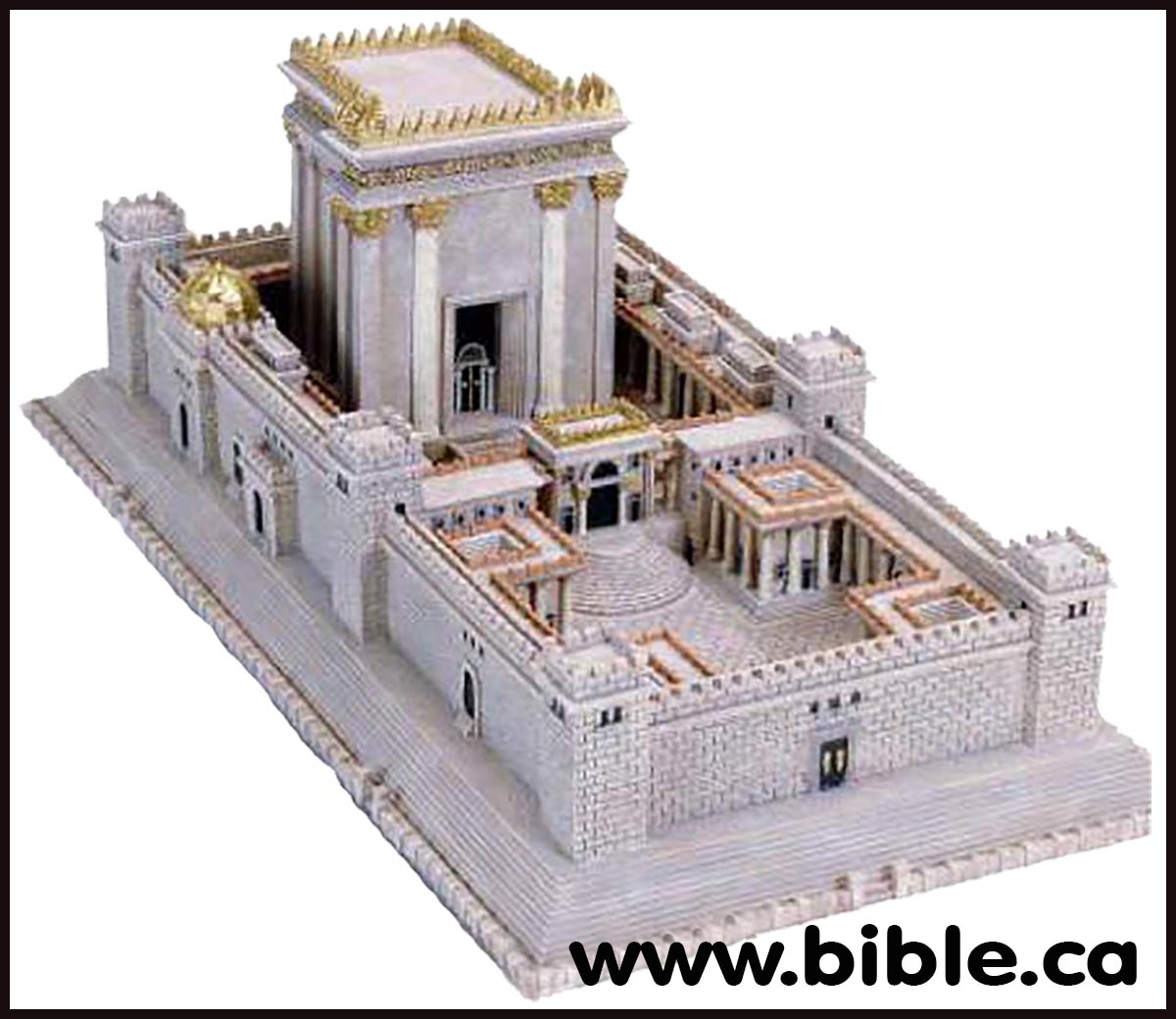
5. 700t-699 BC — Sabbatical year: Sabbatical year during Sennacherib’s siege of Hezekiah: 2 Kings 19:29
a. "Then this shall be the sign for you: you will eat this year what grows of itself, in the second year what springs from the same, and in the third-year sow, reap, plant vineyards, and eat their fruit." (2 Kings 19:29)
b. 700t/699 BC was a Sabbatical year, being 100 Sabbatical cycles (700 years) after the first Sabbatical year in 1400t/1399 BC.
c. Sennacherib’s siege of Hezekiah occurred in the year before the Sabbatical year 700t/769 BC, which is called the “second year” after the invasion of Sennacherib (701 BC) in 2 Kgs 19:29 and Isaiah 37:30.
d. “According to those who accept the reading of the majority of LXX manuscripts of 1 Kings (3 Kings) 6:1, that Temple construction began in the 440th year of the Exodus Era, 700t/699 BC would not be a Sabbatical year, as quite clearly mandated by 2 Kgs 19:29 and Isaiah 37:30; the nearest Sabbatical year would be 702t/701, contradicting the “second year” following Sennacherib’s invasion being a Sabbatical year as given in the 2 Kgs and Isaiah texts. Those who hold to a thirteenth-century Exodus could modify their date of entry into the land according to their fancy. Since they have no scriptural text that supports their position, they then could choose a date for the entry that makes 700t/699 a Sabbatical year. When you don’t have any evidence to back up your theory, it’s easy to adjust things so that your theory matches one or two actual facts, even though it contradicts a lot of other evidence, such as is given throughout the present treatise.” (Rodger Young, editorial comment, AD 2025)
6. 623t-622 BC — 16th Jubilee year: Lost Book of the Law found during the 16th Jubilee year: 2 Kgs 22:3
a. The Book of the Law was found in Josiah’s eighteenth year, 623t/622n. This is 49 years before Ezekiel’s Jubilee in 574t/573 BC, so this would have happened in a Jubilee year, the sixteenth. That the finding of the Law was in a Jubilee year is correctly remembered in Seder Olam, chapter 24, and also in the Babylonian Talmud, Megillah 14b. There are some things in the Seder Olam and other rabbinic literature that are based on historical remembrance, not rabbinic speculation.
b. 16th jubilee in 18th year of Josiah: (16 X 49 = 784) + 623 = 1406 BC (Inclusive)
c. Seder Olam Rabbah says that Hilkiah found the book of the Law in a Jubilee year. “Josiah was 8 years old when he reigned, and for 31 years he reigned in Jerusalem. In the 18th year, the Torah scroll was found in the house of the Lord, and in that year (18th year) it was the beginning of a jubilee, and in that year (18th year) Josiah repaired the house.” (Seder Olam 24:86)
d. The Babylonian Talmud says that Hilkiah found the book of the Law in a Jubilee year. “Is it possible that the Jubilee was null, and the prophet prophesied that it would be nullified” (b. Megillah 14b).
e. “Correct rabbinic account in Seder Olam 24: Two Jubilees were forty-nine years apart: those of Ezekiel and Josiah. Seder ‘Olam, chapter 24, cites 2 Kings 22:3 referring to the eighteenth year of Josiah and then says, “In that year the book of the Torah was found in the Temple and that year was also the beginning of a Jubilee.” The latter part of this statement, that the eighteenth year of Josiah was a Jubilee Year, is missing from some manuscripts of Seder ‘Olam. Guggenheimer omits it in his edition, but remarks that it is found in European manuscripts (211). Other editions of Seder ‘Olam include it as part of the original text, and the fact that rabbinic calculation methods gave forty-seven years between Ezekiel’s Jubilee and the eighteenth year of Josiah explains why later editions of Seder ‘Olam would delete this embarrassment to their presupposition-dominant calculation methods. The text of Ezekiel 40:1 refers to the initiation of the Jubilee Year 574t BC. Thiele’s chronology establishes the eighteenth year of Josiah as 623t BC, a figure with which we agree. These two dates are forty-nine years apart, in harmony with the forty-nine-year Jubilee cycle. But this presents an insurmountable problem to rabbinic chronological methods. Those methods originated in Seder ‘Olam and perhaps earlier works, and they are accepted without question in the Babylonian Talmud. The problem is that rabbinical chronology would assign only forty-seven years between the eighteenth year of Josiah and Ezekiel’s vision (Ezek 40:1), meaning that they could not both be Jubilee Years in the rabbinic system.” (Rodger Young, editorial comment, AD 2025)
7. 598t-597 BC: 25th year of captivity of Ezekiel and Jehoiachin: 598t/597 BC - 24 = 574t/573 BC.
a. This is important, because Ezekiel 40:1 says the Jubilee in 574 BC occurred in the 25th year since Jehoiachin’s and Ezekiel’s captivity: 574 + 24 (inclusive) = 598t/97
b. The 70-year Babylonian captivity began in the summer of 605 BC with Nebuchadnezzar’s first attack of Jerusalem when Daniel, Shadrach, Meshach, and Abednego.
c. Nebuchadnezzar’s second attack began on the 16th December 598 and ended on the 16 March 597 BC when Jehoiachin and Ezekiel were captured and deported to Babylon. March 16, 597 BC, was in the Judean regnal year 598t/597; this was year one of captivity, so that year 25 was 598t/597 BC – 24 = 574t/573 BC, the year of the seventeenth (Ezekiel’s) Jubilee.
d. Nebuchadnezzar’s third attack began in January 589 and ended on Monday 28th August 587 BC (10th Av 587 BC) when the temple was burned during a Sabbatical year.
8. 588t-587 BC— Sabbatical year: This was a Sabbatical year when the Temple was burned, and Joel was written: Jeremiah 34:8-22
a. The temple was destroyed twice in 587 BC and AD 70 on the same Hebrew day of the year, “10th Av” and both on Sabbatical years.
b. On the 10th Av 587 BC, Solomon’s temple was burned by the Edomites and destroyed under the supervision of the Babylonians. (Jer 52:12; Josephus Antiquities 10:146; Wars 6.249–250; Wars 6:268; Ps 137:7; 1 Esdras 4:45)
i. "Now on the tenth day of the fifth month, which was the nineteenth year of King Nebuchadnezzar, king of Babylon, Nebuzaradan the captain of the bodyguard, who was in the service of the king of Babylon, came to Jerusalem." (Jeremiah 52:12)
ii. “When he had carried these off, he set fire to the temple in the fifth month, the first day of the month, in the eleventh year of the reign of Zedekiah, and in the eighteenth year of Nebuchadnezzar; he also burnt the palace, and overthrew the city.” (Antiquities 10.146)
iii. “However, one cannot but wonder at the accuracy of this period thereto relating; for the same month and day were now observed, as I said before, wherein the holy house was burnt formerly by the Babylonians.” (Wars 6:268)
iv. “So Titus retired into the tower of Antonia, and resolved to storm the temple the next day, early in the morning, with his whole army, and to encamp round about the holy house; (250) but, as for that house, God had for certain long ago doomed it to the fire; and now that fatal day was come, according to the revolution of ages; it was the tenth day of the month Lous [Ab], upon which it was formerly burnt by the king of Babylon.” (Wars 6.249–250)
v. "Remember, O Lord, against the sons of Edom The day of Jerusalem, Who said, “Raze it, raze it To its very foundation.”" (Psalm 137:7)
vi. “Thou also hast vowed to build up the temple, which the Edomites burned when Judea was made desolate by the Babylonians.” (1 Esdras 4:45)
c. "The word which came to Jeremiah from the Lord after King Zedekiah had made a covenant with all the people who were in Jerusalem to proclaim release to them: that each man should set free his male servant and each man his female servant, a Hebrew man or a Hebrew woman; so that no one should keep them, a Jew his brother, in bondage. And all the officials and all the people obeyed who had entered into the covenant that each man should set free his male servant and each man his female servant, so that no one should keep them any longer in bondage; they obeyed, and set them free. But afterward they turned around and took back the male servants and the female servants whom they had set free, and brought them into subjection for male servants and for female servants. Then the word of the Lord came to Jeremiah from the Lord, saying, “Thus says the Lord God of Israel, ‘I made a covenant with your forefathers in the day that I brought them out of the land of Egypt, from the house of bondage, saying, “At the end of seven years each of you shall set free his Hebrew brother who has been sold to you and has served you six years, you shall send him out free from you; but your forefathers did not obey Me or incline their ear to Me. “Although recently you had turned and done what is right in My sight, each man proclaiming release to his neighbor, and you had made a covenant before Me in the house which is called by My name. “Yet you turned and profaned My name, and each man took back his male servant and each man his female servant whom you had set free according to their desire, and you brought them into subjection to be your male servants and female servants.” ’ “Therefore thus says the Lord, ‘You have not obeyed Me in proclaiming release each man to his brother and each man to his neighbor. Behold, I am proclaiming a release to you,’ declares the Lord, ‘to the sword, to the pestilence and to the famine; and I will make you a terror to all the kingdoms of the earth. ‘I will give the men who have transgressed My covenant, who have not fulfilled the words of the covenant which they made before Me, when they cut the calf in two and passed between its parts— the officials of Judah and the officials of Jerusalem, the court officers and the priests and all the people of the land who passed between the parts of the calf— I will give them into the hand of their enemies and into the hand of those who seek their life. And their dead bodies will be food for the birds of the sky and the beasts of the earth. ‘Zedekiah king of Judah and his officials I will give into the hand of their enemies and into the hand of those who seek their life, and into the hand of the army of the king of Babylon which has gone away from you. ‘Behold, I am going to command,’ declares the Lord, ‘and I will bring them back to this city; and they will fight against it and take it and burn it with fire; and I will make the cities of Judah a desolation without inhabitant.’ ”" (Jeremiah 34:8–22)
d. Joel written: Joel provided light and hope in view of the imminent destruction of the physical temple in the Messianic age when, in the 1000th year later, the spiritual temple, the church would be established on Pentecost AD 33. Salvation from sins would be proclaimed through the blood of Christ, faith, repentance and water baptism.
|
“It will come about after this That I will pour out My Spirit on all mankind; And your sons and daughters will prophesy, your old men will dream dreams, Your young men will see visions. “Even on the male and female servants I will pour out My Spirit in those days. “I will display wonders in the sky and on the earth, Blood, fire and columns of smoke. “The sun will be turned into darkness And the moon into blood Before the great and awesome day of the Lord comes. “And it will come about that whoever calls on the name of the Lord Will be delivered; For on Mount Zion and in Jerusalem There will be those who escape, As the Lord has said, Even among the survivors whom the Lord calls." (Joel 2:28–32) “Repent, and each of you be baptized in the name of Jesus Christ for the forgiveness of your sins." (Acts 2:38) |
|
9. 574t-573 BC— 17th Jubilee year: Ezekiel 40:1 describes the 17th Jubilee
a. “In the twenty-fifth year of our exile, on New Year’s Day (Rosh HaShanah), on the tenth of the month, in the fourteenth year after the city was taken, on that same day the hand of the Lord was upon me and He brought me there." (Ezekiel 40:1)
b. Ezekiel 40:1 is unique in scripture because it contains a triple dating synchronism for the Jubilee. The first dating synchronism says the Jubilee occurred in the 25th year of his own personal captivity that began in 598 BC. The second dating synchronism says the Jubilee occurred when the new year fell on the 10th of the month, which only occurred on the Jubilee year and no other. The third dating synchronism says the Jubilee occurred in the 14th year after the destruction of Solomon’s temple, which also marks the burning of the temple on a Sabbatical year, because 14 is divisible by 7. Jewish literary sources widely discuss the 17th Jubilee and are in universal agreement.
c. Rabbis, following Seder Olam chapter 30, started with the presupposition that Israel had to be in its land an exact number of Jubilee cycles, which is a wrong presupposition. For that reason, they maintained that the start of counting was delayed until 14 years after the entry into the land, which contradicts Lev 25:2, “When you enter the land.” Why didn’t they just move the Jubilee back to 588t/587 when the city fell; then everything would work out with Israel being in its land for 16 full Jubilee cycles? They knew they couldn’t do that, because it would contradict both the text of Ezekiel 40:1 and the knowledge that Ezek 40:1 was known historically to start the seventeenth Jubilee. They could not change this, and so, as many modern writers do, they invented a new presupposition to support their wrong presupposition that Israel had to be in its land an exact number of Jubilee cycles.
d. 574 BC was 17th jubilee: SO 11:48; b. Arakin 12A; “17 jubilee cycles”: b. Arakin 12B
e. 574 BC was the 25th year of Ezekiel’s captivity: 574 + 24 (inclusive) = 598t/97
f. 574 BC was the 14th year after temple destroyed: 574 + 14 = 588t-587 BC
g. Rosh Hashanah was observed on the tenth of the month only in a jubilee year: (b. Arakin 12a, 12b, and SO 11).
h. Seder Olam 11:48 “17 entire jubilee periods”
i. “One must say that it (574 BC) is the Jubilee year” (b. Arakin 12A)
j. “R. Ashi holds that the statement ‘the same happened with the second Temple’ refers also to the termination of the jubilee and explains it by deducting six years from the total of 420” (Comment by translator of Arakhin 12A, Soncino Press, Rabbi Isidore Epstein, 1935–1952)
k. “seventeen jubilee cycles” (b. Arakin 12B)
l. “Has it not been written [in Scripture], “In the twenty-fifth year of our captivity, in the beginning of the year, in the tenth day of the month, in the fourteenth year after the city had been smitten” [Ez. 40:1, the year the sanctuary was destroyed]. Now what is the year, the first day of which falls on the tenth of the month [and not on the first of Tishré]? One must say that it (Ezek 40:1) is the Jubilee year [on which the new year coincides with the Day of Atonement, and thus it could not have been the first year of the seven-year cycle, as A has maintained].” (Babylonian Talmud Arakin 12A)
m. “For it has been taught on Tannaite authority: “The Israelites counted seventeen septennates (Jubilees) from the time that they entered the Land until they left it. But you cannot maintain the position that they [actually] began counting from the moment at which they entered the Land, for, if you do so, it turns out that the Temple was destroyed at the beginning of a Jubilee cycle [not merely the first year of a sabbatical cycle, but the first year of a jubilee cycle,] in which case you cannot square matters with the statement [of Ezekiel], “In the fourteenth year, after the city was smitten” (Ez. 40:1). [That is, the destruction took place fourteen years after a Jubilee had started].” (Babylonian Talmud Arakin 12B)
n. “The Israelites counted seventeen septennates (Jubilees) from the time that they entered the Land until they left it. But you cannot maintain the position that they began counting from the moment at which they entered the Land, for, if you do so, it turns out that the Temple was destroyed at the beginning of a Jubilee cycle, in which case you cannot square matters with the statement [of Ezekiel], “In the fourteenth year, after the city was smitten” (Ez. 40:1).” (Babylonian Talmud Arakin 13A)
10. Jubilee and Sabbatical cycles stopped during Babylonian captivity and restarted in 533 BC when Jews returned to Jerusalem.
a. In hindsight, Israel had already been in exile since 587 BC when the seventeenth Jubilee began on Tishri 10, 574 BC. Israel was in the land for 16 complete Jubilees and was deported between the 16th and 17th Jubilee in 574 BC.
b. There is nothing in scripture or prophecy that required Israel to be in the land a full 17 Jubilees, despite Rabbinical claims to the contrary, which amounts to the rewriting of Jewish history. That Ezekiel’s Jubilee year was the seventeenth Jubilee, however, was remembered as a historical fact that could not be denied, even though it was contrary to the rabbis’ (wrong) presupposition that Israel had to be in its land an exact number of Jubilee cycles. These kinds of chronological contradictions are common in modern Jewish Rabbinical circles which generates endless squabbling and no solutions. Christians today have solved the chronological problems that Jews today disagree about. It is Christians who have established the correct chronology of ancient Jewish history and Jews today should thank Christians for this major and important contribution.
IV. Known Post-captivity Jubilees and Sabbatical years: 533 BC – AD 749
|
Sabbatical and Jubilee years 533 BC — AD 749 New Anchor year 1: 533 BC |
||
|
|
Sabbaticals |
Jubilees |
|
1st Sabbatical year |
527t-526 BC |
|
|
Sabbatical year |
2t-1 BC |
|
|
Sabbatical year |
AD 6t-7 |
|
|
Sabbatical year |
AD 13t-14 |
|
|
Sabbatical year |
AD 27t-28 |
|
|
Sabbatical year |
AD 34t-35 |
|
|
Sabbatical year |
AD 20t-21 |
|
|
Sabbatical year |
AD 2022t-2023 |
|
|
Future Sabbatical |
AD 2029t-2030 |
|
|
Jubilee #1 |
|
485t-484 BC |
|
Jubilee #10 |
|
44t-43 BC |
|
Jubilee #11 |
|
AD 6t-7 |
|
Jubilee #52 |
|
AD 2015t-2016 |
|
Future Jubilee #53 |
|
AD 2064t-2065 |
1. 533t-532
BC — Anchor year when Sabbatical cycle counting was restarted: The 70-year
Babylonian captivity began in 605 BC and ended in 537n/536t
with the decree of Cyrus. It took almost 4 years for the Jews to organize and
travel home to Jerusalem in 533 BC. This is year 1 of the Sabbatical cycle and
the first Sabbatical year was 6 years later in 527t-526 BC, after which
Sabbatical years are 7 years apart. Historians were unable to determine when
and if the Jews began counting Sabbatical years until they assembled a collection
of ancient Jewish literary sources which named Sabbatical years which all
harmonized with 533 BC, confirming the chronology listed in Ezra and Nehemiah.
It appears that after the Babylonian captivity Jews abandoned the 49 year
Jubilee cycle because there are no known ancient literary sources to support
it.

2. 527t-526 BC — Sabbatical year: This is the first Sabbatical year after the Babylonian captivity when they arrived in Jerusalem in 533t-532. It is important to remember that since 533 BC when they arrived was year 1 of the Sabbatical cycle, that the first Sabbatical year began 6 years later in 527t BC. Inside the Sabbatical year calendar, years are 7 years apart.
3. 443t-442
BC — First recorded Sabbatical year kept after captivity. Nehemiah 10:31
dates to the 20th year of Artaxerxes which
is 445n/444 BC. In 445t BC Ezra reads the law in public
on his wooden podium, then later that year covenants the people to start
keeping Sabbaths and Sabbatical years through a formal signed legal document:
Neh 8:8; 10:31. The first recorded Sabbatical year the Jews kept after
returning from captivity was in 443t-442. This marks the restoration of the
Sabbatical year where recounting the Sabbatical cycle was restarted in 533 BC.
There is no reference to keeping Jubilees. During Ezra’s public readings
of the Book of the Law he stood with 13 other named men on his wooden platform:
Nehemiah 8:1–5. It was in 445 BC that Ezra released the
updated canon of the Hebrew Bible (the Quattuordecim) begun in 458 BC, by
replacing the Paleo-Hebrew script of Samuel with the Aramaic script used in the
Dead Sea scrolls, Jesus, and modern Jews. Ezra’s script, named “Quattuordecim”
by Steven Rudd in AD 2016, refers to the 14 men who stood on the wooden podium
when the new script was first published and read to the public. The Hebrew text
was identical, except a different script style, which Rudd named, “Aramaic
Hebrew” was used to write it.
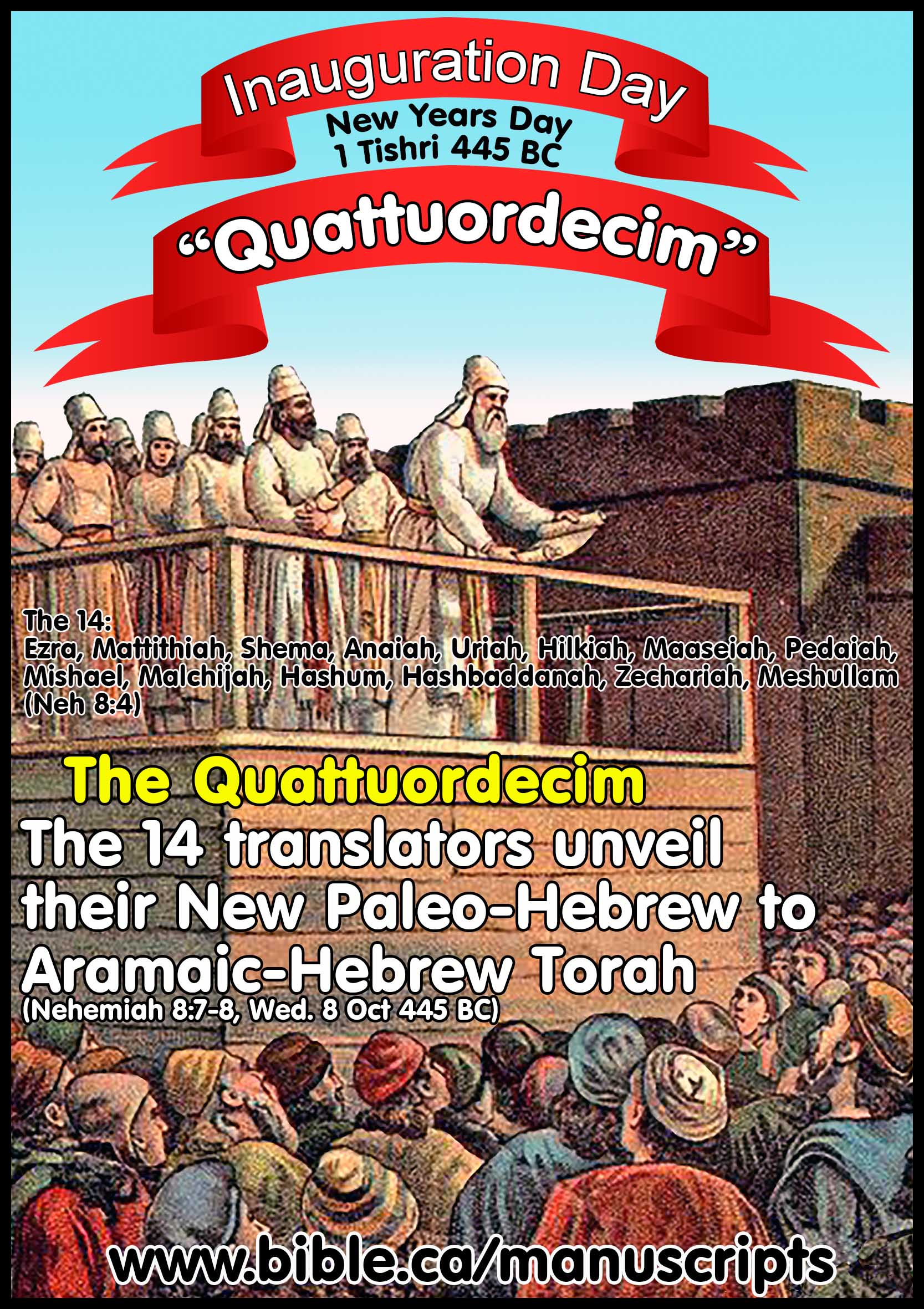
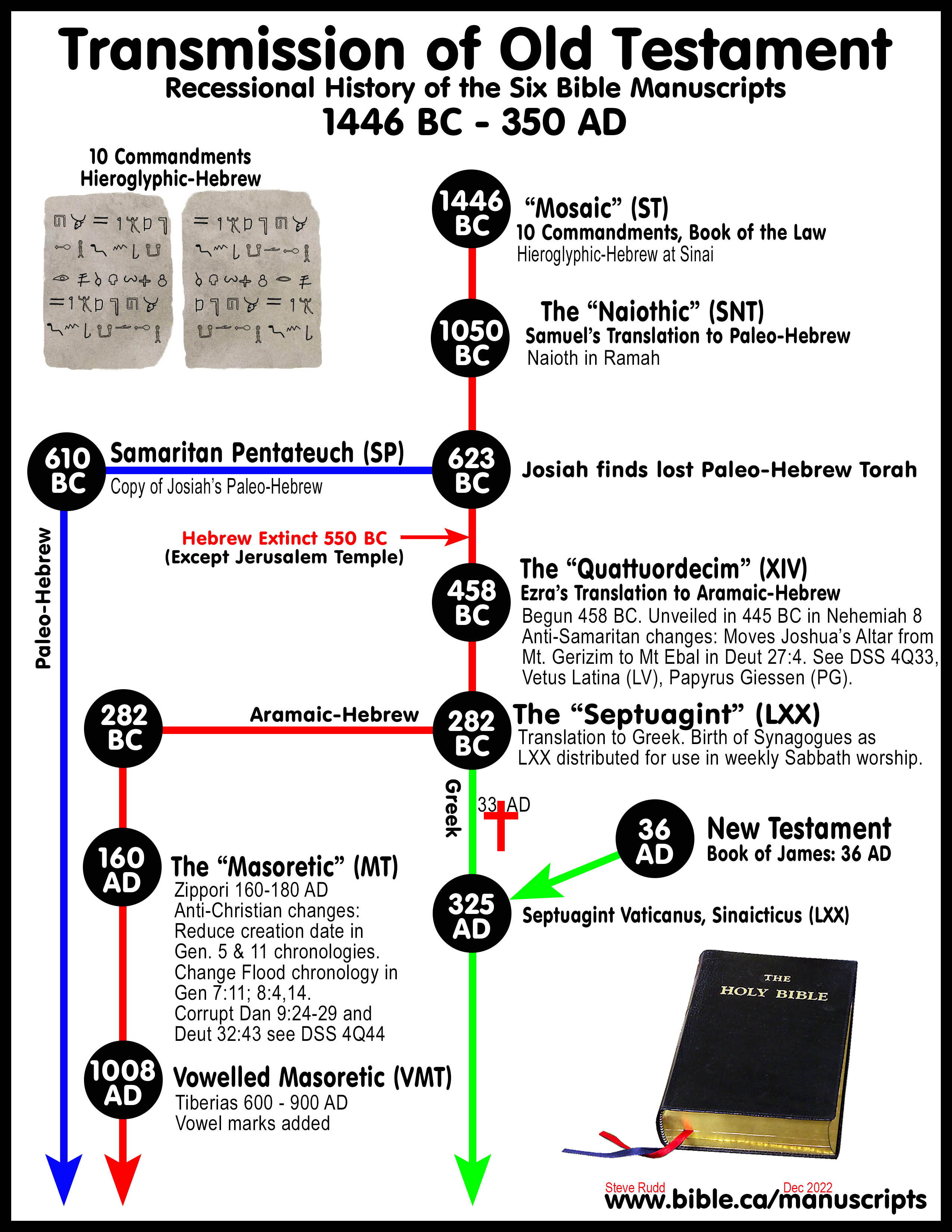
a. "And all the people gathered as one man at the square which was in front of the Water Gate, and they asked Ezra the scribe to bring the book of the law of Moses which the Lord had given to Israel. Then Ezra the priest brought the law before the assembly of men, women and all who could listen with understanding, on the first day of the seventh month. He read from it before the square which was in front of the Water Gate from early morning until midday, in the presence of men and women, those who could understand; and all the people were attentive to the book of the law. Ezra the scribe stood at a wooden podium which they had made for the purpose. And beside him stood Mattithiah, Shema, Anaiah, Uriah, Hilkiah, and Maaseiah on his right hand; and Pedaiah, Mishael, Malchijah, Hashum, Hashbaddanah, Zechariah and Meshullam on his left hand. Ezra opened the book in the sight of all the people for he was standing above all the people; and when he opened it, all the people stood up." (Nehemiah 8:1–5)
b. "As for the peoples of the land who bring wares or any grain on the sabbath day to sell, we will not buy from them on the sabbath or a holy day; and we will forego the crops the seventh year and the exaction of every debt." (Nehemiah 10:31)
4. 331t/330 BC — Sabbatical year: The request for remission of taxes under Alexander the Great occurred on a Sabbatical year: Antiquities 11.337–338
a. “And when the book of Daniel was showed him (Alexander the Great), wherein Daniel declared that one of the Greeks should destroy the empire of the Persians, he supposed that himself was the person intended; and as he was then glad, he dismissed the multitude for the present, but the next day he called them to him, and bade them ask what favors they pleased of him: (338) whereupon the high priest desired that they might enjoy the laws of their forefathers, and might pay no tribute on the seventh year. He granted all they desired: and when they entreated him that he would permit the Jews in Babylon and Media to enjoy their own laws also, he willingly promised to do hereafter what they desired.” (Antiquities 11.337–338)
5. 163t/162 BC — Sabbatical year: The second battle of Beth-Zur occurred during a Sabbatical year.
a. 1 Maccabees 6:20,49; Josephus, Antiquities 12.378
b. "And from the army of the king, they went up to meet them in Jerusalem, and the king camped in Judah and in Mount Zion. And he made peace with those from Beth-zur, and he came out from the city because there were no supplies for them there to close themselves in it, because it was a Sabbath year for the land." (1 Maccabees 6:48–49)
c. And when Antiochus had thus taken the city, he did them no other harm than sending them out naked. He also placed a garrison of his own in the city: (377) but as for the temple of Jerusalem, he lay at its siege a long time, while they bravely defended it from within; for whatever engines the king set against them, they set other engines again to oppose them. (378) But then their provisions failed them; what fruits of the ground they had laid up were spent, and the land was not ploughed that year, continued unsowed, because it was the seventh year, on which, by our laws, we are obliged to let it lie uncultivated. And withal, so many of the besieged ran away for want of necessaries, that but a few only were left in the temple. (Josephus, Antiquities 12.376-378)
6. 135t/134 BC — Sabbatical year: The murder of the Hasmonean Simon occurred during a Sabbatical year.
a. 1 Macc 16:14–21; Antiquities 13.234; Josephus, Wars 1.60
b. "And the son of Abubus welcomed them with deceit into the small fortification called Dok, which he had built. And he made for them a great feast and hid men there. And when Simon and his sons had become drunk, Ptolemy and those with him stood and took their weapons and rushed to attack Simon in the banquet and killed him and his son and some of his servants. And he performed a great godlessness and repaid evil for good. And Ptolemy wrote about these things and sent it to the king so that he might send to him troops to help and hand over their region and cities. And he sent others into Gazara to remove John; and to the commanders he sent messages for them to come to them so that he might give them gold and silver and gifts. And others he sent to capture Jerusalem and the mountain of the temple. But running ahead, someone reported to John in Gazara that his father and his brothers had been killed and that he had sent men also to kill you. And hearing these things, he was shocked incredibly, and he captured the men who had come to kill him and executed them, for he knew that they sought to kill him." (1 Maccabees 16:15–22)
c. “as the siege was drawn out into length by this means, that year on which the Jews use to rest, came on; for the Jews observe this rest every seventh year, as they do every seventh day; so that Ptolemy being for this cause released from the war, he slew the brethren of Hyrcanus and his mother.” (Antiquities 13.234–235)
d. “And as the siege was delayed by this means, the year of rest came on, upon which the Jews rest every seventh year as they do on every seventh day. On this year, therefore, Ptolemy was freed from being besieged, and slew the brethren of John, with their mother.” (Josephus, Wars 1.60)
7. 37t/36
BC — Sabbatical year: Conquest of Jerusalem by Herod occurred on a
Sabbatical year.

a. Antiquities 14.475; 15:7; Wars 1.345-47
b. “They also erected new works when the former were ruined, and making mines under ground, they met each other, and fought there; and making use of brutish courage rather than a prudent valor, they persisted in this war to the very last; and this they did while a mighty army lay round about them, and while they were distressed by famine and the want of necessaries, for this happened to be a Sabbatic Year.” (Antiquities 14.475)
c. “This distress was in part occasioned by the covetousness of the prince regent, who was still in want of more, and in part by the Sabbatic Year, which was still going on, and forced the country to lie still uncultivated, since we are forbidden to sow the land in that year.” (Antiquities 15.7)
d. “When he had thus married Mariamne, he came back to Jerusalem with a greater army. Sosius also joined him with a large army, both of horsemen and footmen, which he sent before him through the midland parts, while he marched himself along Phoenicia; (346) and when the whole army was gotten together, which were eleven regiments of footmen, and six thousand horsemen, besides the Syrian auxiliaries, which were no small part of the army, they pitched their camp near to the north wall. Herod’s dependence was upon the decree of the senate, by which he was made king; and Sossius relied upon Antony, who sent the army that was under him to Herod’s assistance.” (Wars 1.345-47)
e. “Since this is dated to year 3, as measured from Herod’s appointment as king of Judea by the Romans in late 39 BC, this year number (3) is the earliest time he could have minted a coin, since he did not capture Jerusalem until three years after his appointment. This coin by itself contradicts the assumption of those who date Herod’s appointment by the Romans in late 40 BC and his conquest of Jerusalem in 37 BC, because those who follow that dating always assume that Herod (and Josephus, who is the main source for the history of Herod) always used non-accession counting for the Herodians. If that had been the case, “year 3” of Herod would really have been only two actual years after his appointment by the Romans, and he would not yet have been able to mint a coin because he had not yet taken control of Judea. But if the Herodians, and their historian Josephus, used accession counting for Herod, then the “conventional” date for Herod’s death, 4 BC, cannot stand; he must have died in 1 BC, as has been firmly supported by recent scholarship, starting with Filmer in 1966. The most recent study in this regard is Steinmann and Young’s “Dating the Death of Herod and the Reigns of His Sons”, Bibliotheca Sacra 178 (2021). Of the thousands or tens of thousands of coins of the Herodians that have been found and which have a date (regnal year) on them, all of these dated coins agree with Herod dying in 1 BC. All contradict the dating of his death to 4 BC.” (Rodger Young, editorial comment, AD 2025)
8. Birth of Christ — Not a Sabbatical year in spring of 2 BC occurred 6 months before the Sabbatical year began in the fall of 2 BC).
a. The Sabbatical year was 2t-1BC. 2t means Tishri (fall-Jewish new year) of 2 BC to the fall of 1 BC.
b. In AD 200, Clement dated the birth of Christ around Passover 2 BC on the 25th of “Pashon”. Pashon is the 9th Egyptian month that corresponds to Passover sometime in April/May. The 28th year of Augustus is 2 BC.
c. “And there are those who have determined not only the year of our Lord’s birth, but also the day; and they say that it took place in the 28th year of Augustus, and in the 25th day of Pachon.” (Clement, Stromota 1:21, AD 200).
9. Ministry of Christ — No Sabbatical years in the window of AD 29-33
a. There were no Sabbatical years during the 3 ½ year ministry of Christ that began in AD 29 and ended in AD 33.
b. AD 27t-28 and AD 34t-35 were Sabbatical years.
10. Pentecost Sunday 24 May AD 33: Solomon’s temple to Church in the 1000th year!
a. Although not a Sabbatical year, the founding of the church was the fulfillment of Ezekiel’s third temple: Ezek 40-48.
b. The spiritual church temple was established in the 1000th year after the physical temple was established in 967 BC (967 - 1 no zero year + 33 = 999 years)
c. Just as the 480th year of 1 Kings 6:1 is 490 years back to 1446 BC, so too the 1000th year from temple to church is 999 years.
11. AD 41t/42 — Sabbatical
year: Agrippa I reads Deuteronomy 17:15 on a Sabbatical year.

a. Mishnah Sotah 7:8; Antiquities 18.271-72; Wars 2.200
b. “The Torah reading of King Agrippa I (Acts 12:1-2) — how so? At the end of the first festival day of the Festival [of Sukkot], on the Eighth Year, [that is] at the end of the Seventh Year, they make him a platform of wood, set in the courtyard. And he sits on it, as it is said, At the end of every seven years in the set time (Sabbatical year: Dt. 31:10). The minister of the assembly takes a scroll of the Torah and hands it to the head of the assembly, and the head of the assembly hands it to the prefect, and the prefect hands it to the high priest, and the high priest hands it to the king, and the king stands and receives it. But he reads sitting down. Agrippa the King stood up and received it and read it standing up, and sages praised him on that account. And when he came to the verse, You may not put a foreigner over you, who is not your brother (Dt. 17:15), his tears ran down from his eyes. They said to him, “Do not be afraid, Agrippa, you are our brother, you are our brother, you are our brother!” He reads from the beginning of These are the words (Dt. 1:1) to Hear O Israel (Dt. 6:4), Hear O Israel (Dt. 6:4), And it will come to pass, if you hearken (Dt. 11: 13), and You shall surely tithe (Dt. 14:22), and When you have made an end of tithing (Dt. 26:12–15), and the pericope of the king [Dt. 17:14–20], and the blessings and the curses [Dt. 27:15–26], and he completes the whole pericope. With the same blessings with which the high priest blesses them [M. 7:7F], the king blesses them. But he says the blessing for the festivals instead of the blessing for the forgiveness of sin.” (Mishnah Sotah 7:8, 200 AD)
c. “These thought they must run a mighty hazard if they should have a war with the Romans, but judged that the transgression of the law was of much greater consequence, (271) and made supplication to him, that he would by no means reduce them to such distresses, nor defile their city with the dedication of the statue. Then Petronius said to them, “Will you then make war with Caesar, without considering his great preparations for war and your own weakness?” They replied, “We will not by any means make war with him; but still we will die before we see our laws transgressed.” So they threw themselves down upon their faces, and stretched out their throats, and said they were ready to be slain; (272) and this they did for forty days together, and in the meantime left off the tilling of their ground (Sabbatical year), and that while the season of the year required them to sow it (They did not sow during the normal time of sowing). Thus they continued firm in their resolution, and proposed to themselves to die willingly rather than to see the dedication of the statue.” (Antiquities 18.270–272)
d. “But as they could no way be prevailed upon, and he saw that the country was in danger of lying without tillage, for it was about seed-time that the multitude continued for fifty days together idle.” (Wars 2.200)
12. AD 55t/56 — Sabbatical
year: Loan during Sabbatical year Wadi Murabba‘at

a. Dead Sea Scroll from Wadi Murabba‘at (DSS: Mur18, line 7)
b. “Zachariah bar Yehohanan signed a deed for Abshalom bar Hanin, promising the repayment of twenty (and ?) denars which he had borrowed during a Sabbatical year.” (Calendar of Sabbatical cycles during the second temple and the early rabbinic period, Ben Zion Wacholder, Hebrew Union College Annual, Vol. 44, p171, 1973)
c. “Year two of Nero Caesar (AD 55t/56) in Swya׳, declared by Abshalom bar Hanin, of Swyah. in his presence, of my own accord, that I Zachariah bar Yehohanan bar H ? dwelling in Keslon, silver denars twenty I will not sell until the time of this, I will pay you in five and possibly in its entirety; in this year of Release (Sabbatical year); and if not so, I will make a payment to you from my properties, even those that I will buy later, will be pledged to you as mortgage.” (DSS: Mur18, lines 1-8)
d. “The manuscript fragments from Murabba’at are mostly documents of the second century A.D. in Greek, Aramaic, and Hebrew. A notable exception is a sixth century B.C. papyrus inscribed in archaic Hebrew with a list of names and numbers. Actually, the piece is a palimpsest. The “underwriting” seems to have been a letter though only a few words can be made out now. A few biblical texts were recovered, all from the second century A.D.: Genesis, Exodus, Deuteronomy, and Isaiah, and one phylactery. The biblical documents exhibit a text identical with the Massoretic tradition, even in details of orthography. In addition, there are cursive Aramaic, and Greek business documents, both types frequently bearing date formulae. Several Hebrew letters on papyrus were found. They include letters written by Simon ben Kaseba (bar Kokheba), leader of the Revolt of A.D. 132–135, to guerillas in the Murabba’at region. One has been published by Abbe J. T. Milik in which there is a reference in the laconic text to a group of “neutralists” in the war between Rome and the Jewish insurgents. They are called “Galileans,” and, as Milik suggests, conceivably may be Christians.” (Biblical Archaeologist: Volume 17, The Manuscripts of the Dead Sea Caves, Frank M. Cross, Jr., 1954 AD)
13. AD 69t/70 — Sabbatical year: Destruction of the temple in Jerusalem on (10th Av) Monday, 6th August AD 70. AD 69t/70
a. Seder Olam Rabbah 30:116; Tosesfta Taʿaniyot 3, Jerusalem Talmud Ta'anit 4:5, Babylonian Talmud Ta'anit 29; b. Arakhin 12B
b. In 587 BC and AD 70 both temples were burned on the same day of the year (10th AV), and on Sabbatical years, which Josephus said was not coincidence but a providential act of God (Wars 6.249), God did this so that nobody could misunderstand the YWHW was the one destroying both temples through the agency of the Babylonians and the Romans. See discussion above regarding the technical details of the mistranslated sections of Rabbinical literature below.
c. Translated correctly: “R. Yose says: A day of rewards attracts rewards and a day of guilt attracts guilt. You find it said that the destruction of the first Temple was at the end of Sabbath, at the end of a Sabbatical year (Monday, 6th August AD 70), when the priests of the family of Yehoiariv was officiating, on the Ninth of Ab and the same happened the second time. Both times the Levites were standing on their podium and sang. Which song did they sing? (Ps. 94:23) "He repaid them for their evil deeds" The city wall was breached on the Ninth of the Fourth month the first time and on the Seventeenth the second time.” (Seder Olam Rabbah, 30:116, AD 160)
d. Mistranslated: “When the Temple was destroyed the first time, it was the day after the Sabbath and the year after the Sabbatical year. And it was the watch of Jehoiarib, and it was the ninth of Ab. And so in the case of the destruction of the Second Temple.” (Tosefta Taʿaniyot 3:9, Mistranslated by Jacob Neusner 2005 AD)
e. Mistranslated: “When the Temple was destroyed the first time, it was the day after the Sabbath and the year after the Sabbatical year. And it was the watch of Jehoiarib, and it was the ninth of Ab. And so in the case of the destruction of the Second Temple.” (Jerusalem Talmud Ta'anit 4-5, Mistranslated by Jacob Neusner 2005 AD)
f. Arakhin 12 B
i. Translated correctly: “Come and hear: R. Jose said, Good things are brought about on a good [auspicious] day, and evil ones on a bad one. It is said, The day on which the first Temple was destroyed was the ninth of Ab, and it was at the going out of the Sabbath, and at the end of the seventh [Sabbatical] year. The [priestly] guard was that of Jehojarib, the priests and Levites were standing on their platform singing the song. What song was it? And He hath brought upon them their iniquity, and will cut them off in their evil. They had no time to complete [the psalm with] ‘The Lord our God will cut them off’, before the enemies came and overwhelmed them. The same happened the second time [the second Sanctuary's destruction].” (Babylonian Talmud Arakhin 12B, Soncino Press, Rabbi Isidore Epstein, 1935–1952)
ii. Translator’s comment: “R. Ashi holds that the statement ‘the same happened with the second Temple’ refers also to the termination of the jubilee and explains it by deducting six years from the total of 420” (Comment by translator of Babylonian Talmud Arakhin 12A, Soncino Press, Rabbi Isidore Epstein, 1935–1952)
iii. Mistranslated: “And do you find in fact that in the case of the destruction of the second Temple it was the first year of the sabbatical cycle [“after the Sabbatical year”]?” (Babylonian Talmud Arakhin 12B, Mistranslated by Jacob Neusner 2005 AD)
iv. Mistranslated: “THE TEMPLE WAS DESTROYED THE SECOND TIME. Whence do we know this? For it has been taught: Good things come to pass on an auspicious day, and bad things on an unlucky day. It is reported that the day on which the First Temple was destroyed was the eve of the ninth of Ab, a Sunday, and in a year following the Sabbatical year, and the Mishmar of the family of Jehoiarib were on duty and the Levites were chanting the Psalms standing on the Duchan. And what Psalm did they recite? — [The Psalm] containing the verse, And He hath brought upon them their own iniquity; and will cut them off in their own evil.19 And hardly had they time to say, ‘The Lord our God will cut them off’, when the heathens came and captured them. The same thing too happened in the Second Temple.” (Babylonian Talmud Arakhin 12B, Soncino Press, Rabbi Isidore Epstein, 1952)
g. Babylonian Talmud Ta'anit 29A
i. Translated correctly: “it was said that when the first Temple was destroyed it was on the eve preceding the 9th of Abh, which was also the night at the close of the Sabbath and also the close of the Sabbatical year. The watch at the time was that of Jehoyoreb, and the Levites were chanting in their proper places, at that moment reciting the passage [Ps 94:23]: "And he will bring back upon them their own injustice, and in their own wickedness will he destroy them"; and they did not have time to end the passage, which concludes, "yea, he will destroy them--the Lord our God," before the enemy entered and took possession of the Temple. This happened also at the destruction of the second Temple.” (Babylonian Talmud Ta'anit 29A, Michael L. Rodkinson, 1918 AD)
ii. Mistranslated: “They say: When the Temple was destroyed the first time, it was the ninth of Ab, the day after the Sabbath, and the year after the Sabbatical year. And it was the watch of Jehoiarib. [Bavli lacks:] And so in the case of the destruction of the Second Temple.” (Babylonian Talmud Ta'anit 29A, Mistranslated by Jacob Neusner 2005 AD)
14. AD 132t/133 — Sabbatical
year: Rental contracts of Simon bar Kochba during Second Jewish War: AD
132-135.
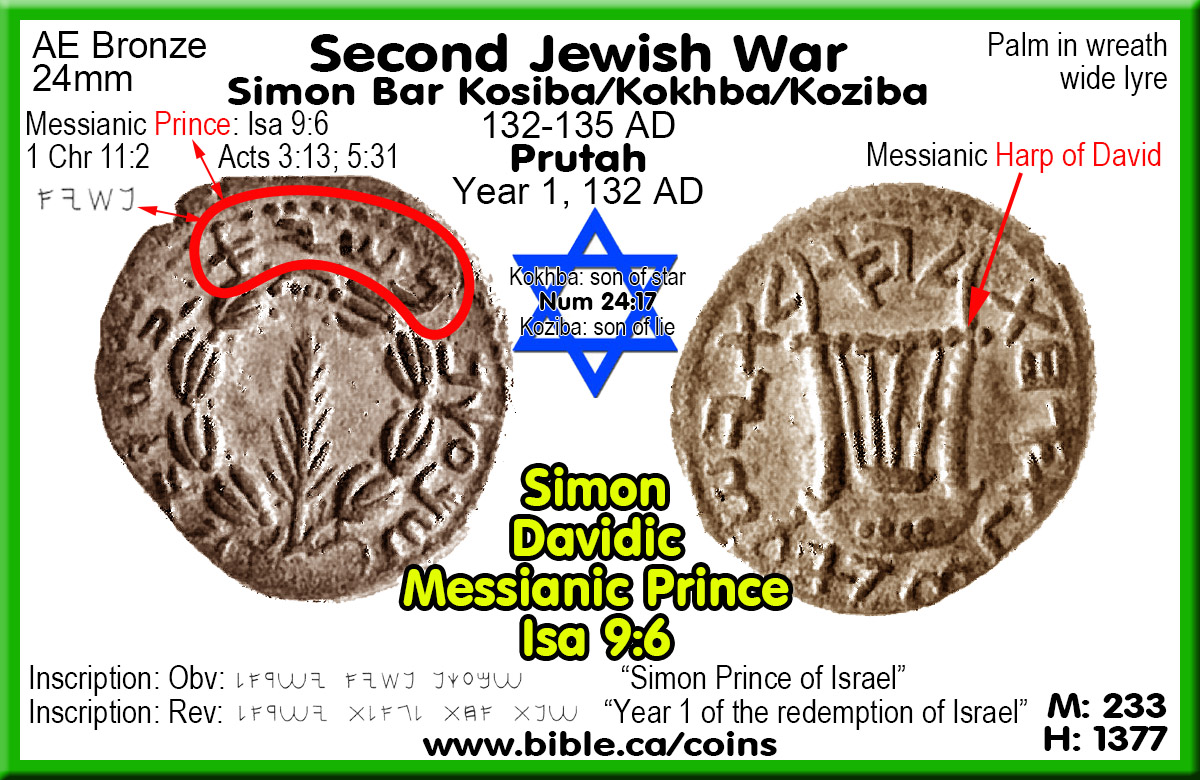

a. “This land which I have rented from you today until the end of the Shemitah (Sabbatical year) (Wadi Murabba‘at: Dead Sea Scroll: Mur24, lines 8-9)
b. “Among the remnants of Simon bar Kosba's (or Kochba's, as he is known from Greek sources) archives found recently at Murabba'at are fragments of a dozen rental contracts which subordinates of the Jewish Prince executed at Herodium. Judging from the remnants, the legal wording of these contracts, aside from the names of the renters, differed slightly, but the state of preservation of Mur 24 A-L ranges from only traces of scattered letters to nearly approaching the original form. Since each of the twelve contracts, written in Hebrew, apparently contained both the same date of issuance and the clause relating to the Sabbatical year, they are crucial for this study. … Milik rightly felt that Mur 24's synchronism of the Sabbatical year with the year of Redemption of Israel would yield a more precise chronology of the Bar Kosba’s rebellion. The rebellion lasted, according to the chronography of Seder Olam, "three and a half years". Since the uprising started in the spring or possibly in the summer of 132, it lasted as attested by Eusebius to the fall or early winter of 135. In terms of Jewish dating, the rebellion commenced in the spring of a pre-Sabbatical year and lasted to the beginning of the fourth year of the next Shemitah cycle, the fourth year of the Redemption of Israel by the Prince of Israel, Shim'on bar Kosba. (Calendar of Sabbatical cycles during the second temple and the early rabbinic period, Ben Zion Wacholder, Hebrew Union College Annual, Vol. 44, p176, 1973)
15. AD 434t/435 — Sabbatical year: Tombstone inscriptions in Sodom, located near Zoar south of the Dea Sea.
a. Three tombstone inscriptions from Sodom reference Sabbatical cycle dating from the destruction of the Jerusalem temple in AD 70, which is referred to as “Churban/Hurban”. So, 364 from Hurban is AD 70 + 364 = 434t-435 AD. The dating system, when adjusted for the year of the Sabbatical cycle, permits the dating of the actual Sabbatical year. Because of scribal error, wear, and damage, the collation of inscriptions A,B,C the sabbatical cycle does not harmonize with each other. Inscription A produces a trusted sabbatical year in AD 434t-435 since 364 is divisible by 7 to equal exactly 52. To calculate the sabbatical year we take AD 69t-70, which was a known sabbatical year and add 364 years for a grand total of 434 years which produces the sabbatical year in AD 434t-435. The other two tombstone inscriptions refer to the sabbatical cycle but produce divergent sabbatical year dates.
b. AD 433t-434 — Sabbatical year: “May the soul rest, of Sha'ul barlat who died on the first of the month of Marheshwan, of the year 1 of the Sabbatical cycle (Shemitah); the year 364 after the destruction (Churban/Hurban) of the House of the Temple. Peace!” (Sodom Tombstone inscription A, lines 1-8, Year 1 = 334t-435 AD)
c. AD 370 — Sabbatical cycle referenced with unknown Sabbatical year: “Here (rests) the soul of Esther the daughter of Edyo, who died in the month of Shevat of the year 3 of the Sabbatical cycle the year 300 of the years of the destruction (Hurban) of the House of the Temple. Peace! Peace! A burnt offering!” (Sodom Tombstone inscription B, lines 1-10)
d. AD 505 — Sabbatical cycle referenced with unknown Sabbatical year: “May the soul rest of Halifo the daughter [of ... ] who died on Tuesday, the eleventh day of the month of Elul, the year 2 of the Sabbatical cycle which is the year 435 years after the destruction (Hurban) of the House of the Temple, Peace to Israel.” (Sodom Tombstone inscription C, lines 1-9)
16. AD 748t-749 — Last known
correct Sabbatical year: The great Israel sabbatical year earthquake of 18
January AD 749. This famous earthquake devastated Israel and is well known in
archaeological circles. For example, this author excavated one of the oldest
Byzantine churches at Kh el-Maqatir first constructed around AD 380 and was
finally destroyed by the AD 749 earthquake. The great earthquake of 18 January
AD 749 was a sabbatical year based upon Cairo Geniza
manuscript (Adler 2038, fol. 5b) which names the event as “the earthquake of
the Sabbatical year” and an Islamic gold Dinar excavated at Beth Shean
in the 1980’s which was minted in A.H. 131, which corresponds to between 31
August 748 and 19 August 749, proving the earthquake occurred after August AD
748. Sometime after AD 748, modern Jewish Sabbatical dating systems introduced
a one-year error absent in the first century AD. The earthquake Sabbatical year
of AD 748t-749 last known Sabbatical year that is a perfect synchronism with
all previously known Sabbatical years back to 533 BC when the Jew arrived in
Jerusalem after the Babylonian Captivity. All modern Jewish sabbatical year
cycles contain a one-year error that is in dissonance with all pre-AD 749
Sabbatical years.
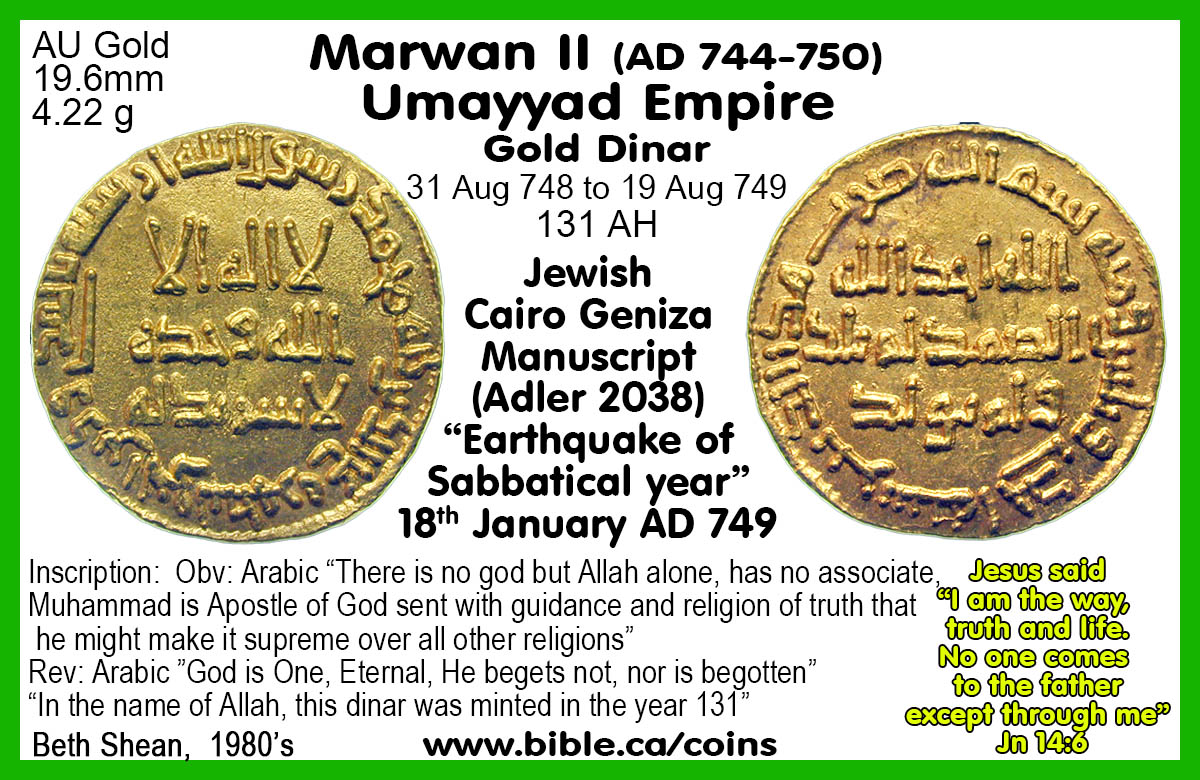
a. “In 1941 M. Margaliot re-examined a Hebrew lamentation from the Cairo Geniza that had been previously published by M. Zulai. The text mourns the death of the many Jews who lost their lives in an earthquake in Tiberias, the Shephelah, and the Sharon valley (the last two terms are probably not employed here in their Biblical geographical application i.e., the hilly region west of the Judean mountains and the coastal valley). The earthquake is called Ra'ash Shevi'i or the 'seventh earthquake '. The lamentation mentions a fast on the 23rd of Shevat. Margaliot argues that that the fast and the lamentation point to the well-known disastrous earthquake of the mid eighth century. Margaliot also shows that the catastrophe is mentioned by the poet Rabbi Pinhas-a hymnologist active no later than the early ninth century-in his piyyut of Qiddush Yerahim (poem on the sanctification of the New Moon), in the part referring to the month of Shevat. This piyyut has been preserved in two manuscripts, Oxford 2852/8 (fol. 40b) and Adler 2038 (fol. 5b), which provide slightly different readings. Both MSS give the dates as the 23rd of Shevat. The Adler MS, which is preferred by Margaliot, mentions the 'fast of the Ra'ash Shevi'it on the 23rd (day) of it (= Shevat)'. The Oxford version names the earthquake Ra'ash Shevi'i. Margaliot bases himself on the version of the Adler manuscript, thus interpreting the term Ra'ash Shevi'it as the 'earthquake of the sabbatical (= seventh) year'” (The Dating of the 'Earthquake of the Sabbatical Year' of 749 C. E. in Palestine, Yoram Tsafrir, Gideon Foerster, Bulletin of the School of Oriental and African Studies, Vol. 55, No. 2, p233, 1992 AD)
b. “Most significant is a hoard discovered [From Beth Shean excavations, 1980’s] in one of the shops which included, among other finds, 31 gold dinars. The earliest coin in this hoard is dated A.H. 78 (March 697-March 698 C.E.) and the latest (see pl. II) was minted in A.H. 131 (31 August 748-19 August 749). This coin is the latest in date of those found hitherto under the ruins of the earthquake by the excavation. Its discovery supplies a clear terminus post quem for the earthquake no earlier than the end of August 748. Clearly this coin, which has survived in mint condition, had found its way into the hands of the trader a very short time before it was buried by the earthquake of 18 January in the year 749.” (The Dating of the 'Earthquake of the Sabbatical Year' of 749 C. E. in Palestine, Yoram Tsafrir, Gideon Foerster, Bulletin of the School of Oriental and African Studies, Vol. 55, No. 2, p234, 1992 AD)
c. Gold Dinar coin inscription details:
i. Jesus, the only begotten Son of God said: “I am the way, truth and life. No one comes to the father except through me” Jn 14:6
ii. Obverse: In the field, three lines inscription: « There is no god but / God, alone / He has no associate ». Marginal inscription: Muhammad is he Apostle of God whom He sent with guidance and the religion of truth that he might make it supreme over all other religions
iii. Reverse: In the field, three lines inscription: « God is One ; / God is Eternal : He begets not / nor is begotten ». Marginal inscription: « In the name of God this dinar was struck in the year … ».
d. “The Seleucid year 1059 therefore falls between April 748 and April 749, and 18 January of the year 749 fits both eras. The last obstacle from Margaliot's point of view was the problem of dating the sabbatical year, since the earthquake is known in the Geniza sources as ' the earthquake of the sabbatical year'. There is an explanation for this apparent discrepancy too. The law of the sabbatical year is still practised in Judaism, and the calculation of the cycles of seven years is believed to date from the creation of the world, but also fits the destruction of the Second Temple. Margaliot emphasizes that according to the present calculation the sabbatical year fell in 747/8, while noting that there existed more than one method of computation. In 1973, Wacholder discussed this matter at length. Using various literary sources and archaeological finds, he showed that the method of calculating the sabbatical cycles in the first centuries C.E. caused a delay of one year in comparison with today's practice. The latest sabbatical year he identified is the year 440/1 C.E. If we extend his calculations and add 308 years (44 cycles of seven years), we arrive at the year 748/9 (4509 of the Jewish era). In this sabbatical year, 18 January coincides exactly with the 23rd of the Hebrew month of Shevat. Thus it becomes clear that the system of calculating the sabbatical year commonly used today came into practice no earlier than the mid eighth century. (The Dating of the 'Earthquake of the Sabbatical Year' of 749 C. E. in Palestine, Yoram Tsafrir, Gideon Foerster, Bulletin of the School of Oriental and African Studies, Vol. 55, No. 2, p235, 1992 AD)
Conclusion:
1. For Christians, the “440” Variant reading of 1 Kings 6:1 is irrelevant because it doesn’t change anything in the New Testament or alter the gospel message of salvation through the blood of Christ. It does reduce the date of both the exodus and creation by 40 years, an issue few lose any sleep over.
2. The “480” reading of the Hebrew MT is correct and the “440” is demonstratable wrong for two reasons:
a. All known Jubilee and Sabbatical years before the end of the Babylonian captivity synchronize perfectly with 480 and all fail to synchronize with 440.
b. Even more devastating to the 440 LXX reading in 1 Kings 6:1, is that Jephthah’s 300 years (Judges 11:26) coincided with 1066 BC, forcing the period of judges to end in 1036 BC which is after Saul became king in 1050 BC and after the birth of David in 1040 BC. The period of the judges cannot extend beyond year 1 of King Saul.
3. Key Biblical and world events occurred during Jubilee and Sabbatical years:
a. The tabernacle was moved from Gilgal to Shiloh by Joshua on a Sabbatical year.
b. Solomon began construction of the Jerusalem temple one year before a Sabbatical year.
c. The book of Hosea was written on a Sabbatical year.
d. Both Jerusalem temples were burned in 587 BC and AD 70 on Sabbatical years.
e. The church was founded in the 1000th year after Solomon’s temple was founded.
f. Sennacherib’s siege of Hezekiah occurred on a Sabbatical year.
g. Josiah found the lost book of the Law on a Jubilee.
h. Ezra released his newly minted copy of the Torah on a Sabbatical year.
i. The great earthquake in AD 749 that rocked Israel occurred during a Sabbatical year.
4. Only two biblical periods of Jubilee and Sabbatical years:
a. Biblical pre-Babylonian exilic: 1406 — 574t BC. Conquest to exile. Uses 1406t BC as anchor year 1.
b. Biblical post-Babylonian exilic: 533t BC – AD 900. Return from exile to AD 900. Uses 533t BC as anchor year 1.
c. Unbiblical modern Rabbinical Jubilee and Sabbatical calendar: AD 900- present. Uses nonbiblical anchor year 1 determined by modern Rabbis.
5. Christians today have solved the chronological problems that Jews today disagree about. It is Christians who have established the correct chronology of ancient Jewish history regarding the date of Creation, Jubilee and Sabbatical years. Jews today should thank Christians for this major and important contribution.
6. “The discussion in Steven Rudd’s monograph on the textual variant of 440 vs. 480 in 1 Kings 6:1, has showed that there is an exact agreement of the historically remembered years in which a Jubilee year occurred: the sixteenth in Josiah’s eighteenth year (623t/622 BC) and the seventeenth, 49 years later in 574t/573 BC (Ezekiel’s Jubilee). Further, the rabbis recognized that the Hebrew text of Ezek 40:1, by putting Rosh HaShanah (New Year’s Day) on the tenth of the month (Lev 25:9), was sufficient in itself to establish that Ezekiel saw his vision at the beginning of a Jubilee year. Thus, in ‘Arakhin 12b of the Babylonian Talmud, the rabbinic author asks this question of his readers, who were assumed to be familiar with Lev 25:8 that specified when the Jubilee year started: “But which year is it when Rosh HaShanah is on the tenth of the month? It must be said that this is a Jubilee.” He assumed that anyone who knew the Torah would find it obvious that the text of Ezek 40:1, by itself and independent of the historical remembrance that Ezek 40:1 really marked the beginning of the seventeenth Jubilee, necessarily implied that Ezekiel saw the vision of the last nine chapters of his book as occurring at the start of a Jubilee year. It’s too bad we can’t assume this knowledge of the Torah, and of the meaning of Ezek 40:1 in the original Hebrew, among modern critics who try to get around all the historical and textual evidence that shows that the sixteenth Jubilee (Josiah’s Jubilee) began in 623t/622 BC and the seventeenth (Ezekiel’s Jubilee) in 574t/573 BC. The trouble, of course, is that to accept these historical and textual facts, would mean that the Sabbatical and Jubilee cycles agree exactly to the year with the date of Israel’s entry into the land as calculated from 1 Kgs 6:1 and Num 14:33. And that means that the book of Leviticus was in existence in 1406 BC, an idea that apparently must be avoided at all costs by those who deny the Mosaic authorship of the Torah. It is this exact agreement that has never been explained by those who do not accept the Bible as historically accurate when it dates the Exodus. As Scott Stripling says “Feinmann and other critics [of the fifteenth-century Exodus] have failed to explain this amazing ‘coincidence.’” (Stripling Five Views on the Exodus, p. 78). We await their explanation, but it apparently it will never come. It is easier to engage in ad hominem attacks, as Scott has experienced, than to admit that the critics have absolutely failed to address this contradiction to their anti-biblical presuppositions.” (Rodger Young, editorial comment, AD 2025)
7. Jubilee and Sabbatical years were abolished by YHWH on the cross in AD 33 along with all other Jewish feast days and animal sacrifices. Christians celebrate the type of the Passover though the Lord’s supper.
a. "Clean out the old leaven so that you may be a new lump, just as you are in fact unleavened. For Christ our Passover also has been sacrificed. Therefore, let us celebrate the feast, not with old leaven, nor with the leaven of malice and wickedness, but with the unleavened bread of sincerity and truth." (1 Corinthians 5:7–8)
By Steve Rudd, edited by Rodger Young: March 2025: Contact the author for comments, input or corrections.
In the final analysis, we can be certain that we possess the word of God!
This is what Jesus meant, when He said: "Scripture cannot be broken" (Jesus, John 10:35)
"My word will accomplish what I desire and succeed in the purpose for which I sent it." (Isa 55:11)
|
The Septuagint LXX “Scripture Cannot Be Broken” |
|||||
|
Start Here: Master Introduction and Index |
|||||
|
Six Bible Manuscripts |
|||||
|
1446 BC Sinai Text (ST) |
1050 BC Samuel’s Text (SNT) |
623 BC Samaritan (SP) |
458 BC Ezra’s Text (XIV) |
282 BC Septuagint (LXX) |
160 AD Masoretic (MT) |
|
Research Tools |
|||||
|
Steve Rudd, November 2017 AD: Contact the author for comments, input or corrections |
|||||
Go to: Main Bible Manuscripts Page
